Saudi Arabia Bets on Natural Gas











Over three months of mass anti-regime protests sweeping Iranian streets, Tehran’s killing machine has been taking its toll on protesters and ordinary people in an attempt to quell the calls against the mullahs’ dictatorship. Shockingly, an increasing number of children fell victims to the regime’s brutal crackdown. Suzan Quitaz outlines a recent report by Amnesty International which detailed the unlawful killings of children by the IRGC. Quitaz pointed out the threats that the anguished families received to keep silent and absolve the regime forces of responsibility, and focused on the report’s finding that majority of the murdered children come from the oppressed ethnic Baluchi and Kurdish minorities.
The recent attack on the United Nations Interim Force in Lebanon adds to Lebanon’s crises, as an international probe into the incident has yet to identify the perpetrators. Lara El-Sayed explores the circumstances of the attack that killed an Irishman and left three others injured, showing the accusations directed to Hezbollah which would be facing a dilemma over the consequences, according to commentators.
This week, Ahmed Taher provides an analysis of the major world events of 2022 that should impact the trends of 2023. From international summits that reflected a shift towards a multipolar world to repercussions of the Ukraine-Russian war, climate change impact on third world countries, and grim economic forecasts for the new year, Taher writes about the possible difficulties and challenges lying ahead in the coming year.
In the Economy Section, Motasem Al Felou highlights Saudi plans to diversify and expand its energy mix, aiming to be the world’s third natural gas producer, but with priority for local businesses. The Saudi energy transformation plans are also targeted to reach net zero by 2060 for better environmental conditions in the Kingdom.
Read these articles and more on our website eng. majalla.com. As always, we welcome and value our readers’ feedback and we invite you to take the opportunity to leave your comments on our website.
A Weekly Political News Magazine www.majalla.com/eng
Editor-in-Chief
The Editor Mostafa El-Dessouki


10th Floor Building 7 Chiswick Business Park 566 Chiswick High Road London W4 5YG
Tel : +44 207 831 8181Fax: +44 207 831 2310









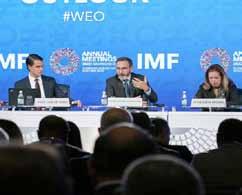





Fans in Buenos Aires celebrate after winning the World Cup - Buenos Aires, Argentina - December 20, 2022 A fan is seen wearing a Lionel Messi mask outside of the Association of Argentinian Football Headquarters ahead of the team arrival /REUTERS





People ice skate at a rink at a Christmas market in St. Petersburg, Russia, Sunday, Dec. 18, 2022./AP


The International Monetary Fund will be watching for a shift by Egypt to a exible exchange rate after a requirement to nance imports through letters of credit is phased out at the end of this month, a senior IMF o cial said on Monday.
The IMF's executive board on Friday approved a 46-month, $3 billion nancial support package for Egypt, saying it included a "permanent shift to a exible exchange rate regime".
Egypt negotiated the loan over seven months as the economic fallout from the war in Ukraine brought a foreign currency shortage to the fore. Shortly before the war, Egypt's central bank imposed the requirement for mandatory letters of credit, causing a sharp slowdown in imports and a backlog of goods in ports.


The Lebanese army and U.N. peacekeepers have held a memorial at Beirut airport for an Irish soldier killed in southern Lebanon last week. U.N. peacekeepers on Sunday stood by 24 year-old Pvt. Seán Rooney’s co n after it had arrived from a hospital the southern city of Sidon. His body was then transferred to a military carrier to be taken back to Ireland. Rooney was killed in a shooting attack by a mob of residents near the southern town of Al-Aqbiya on Wednesday night, as he and seven other Irish peacekeepers from U.N. peacekeeping mission, known as UNIFIL, were on their way to the Beirut airport.

Saudi Arabia’s acquired a company Saudi placement ling on Wednesday. The sale is The UAE-listed Company , its stake in after acquiring Mutlaq Group SR55 million said. On Tuesday, PIF’s stake in about $250 The company to major urban Arabia and

Arabia’s Public Investment Fund (PIF) has 30 per cent stake in cooling Saudi Tabreed through a private of shares, according to a bourse Wednesday. subject to completion procedures.
UAE-listed National Central Cooling known as Tabreed, has also boosted the Saudi venture to 21.8 per cent acquiring additional shares from Al Group for Industrial Investments for million ($14.63 million), the bourse ling
Tuesday, Bloomberg News reported that the in Saudi Tabreed could be worth $250 million.
company provides district cooling services urban developments across Saudi the Gulf region.

The United Arab Emirates’ central bank expects real gross domestic product growth of 7.6 percent this year, an upward revision of more than a percentage point, while lowering expectations for growth next year, state news agency WAM said on Monday.

Two soldiers were killed and three were injured in an explosion in northern Iraq, Iraqi state news said Thursday.
The soldiers were traveling in an army vehicle a day earlier in the Makhmour district when an explosive device detonated, the state Iraqi News Agency reported.
No group immediately claimed responsibility for the attack. It was the latest in a string of similar incidents in recent days.
Eight people were killed and three injured Monday in an attack by gunmen on the village of Albu Bali northwest of Fallujah, previously held by the Islamic State extremist group.
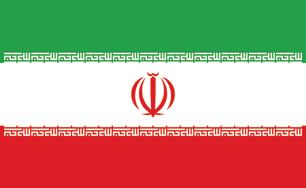
U.N. nuclear watchdog o cials left Iran on Monday after talks with the head of its nuclear energy organization, the semi-o cial ISNA news agency reported, without saying whether they addressed an impasse over uranium traces at undeclared sites.
The issue has been an obstacle to progress in wider talks to revive Iran's 2015 nuclear deal with major powers, meant to curb its disputed uranium enrichment program in return for lifting sanctions imposed by Washington after exiting the pact in 2018.

A powerful magnitude 6.4 earthquake jolted the extreme northern coast of California before dawn on Tuesday, crumpling homes and roads, rupturing utility lines and leaving thousands of residents without running water and electricity.
At least a dozen people were injured, and two others died from "medical emergencies" that occurred during or just after the quake, according to the Humboldt County Sheri 's O ce.
Brazilian President-elect Luiz Inacio Lula da Silva will appoint Senator Jean Paul Prates of his Workers Party to be the next chief executive of state-run oil company Petrobras, a member of his transition team said on Thursday. Deyvid Bacelar, the head of oil workers’ union FUP, revealed Lula’s choice on social media minutes after the leftist leader announced 15 picks for his future cabinet and said his vice president, Geraldo Alckmin, will double as industry and trade minister.
“Based on the diagnosis, alerts, recommendations and information we made available to the president-elect during this complex transition period, he decided to name Senator Jean Paul Prates as Petrobras’ CEO,” Bacelar said in an Instagram post.
,
Only 8.8% of Tunisian voters cast ballots in Saturday's parliamentary elections, authorities announced, after most political parties boycotted the vote as a charade aimed at shoring up President Kais Saied's power.
The provisional turnout gure is below November's 9.8% in ation rate, underscoring the economic pressures that have left many Tunisians disillusioned with politics and infuriated with their leaders.
As Russian cruise missiles sped towards their target this month, a Ukrainian pilot gave chase in an old Soviet MiG-29 ghter jet and locked onto two of them, but could not take the shot: they were nearing a large town and it was too risky.
He said he passed the targets on to Ukraine's ground-based air defences which shot them down, as they have done hundreds of missiles since October, blunting the impact of a Russian air campaign that aims to destroy the country's power grid. "Fortunately for us, they succeeded," the 29-year-old pilot, whose codename is Juice, told Reuters, describing the Dec. 5 incident.
India will start randomly testing 2% of international passengers arriving at its airports for COVID-19, Mansukh Mandaviya, the country's health minister, told parliament on Thursday, as the country steps up surveillance for new coronavirus variants.
Dozens of hearses queued outside a Beijing crematorium on Wednesday, even as China reported no new COVID-19 deaths in its growing outbreak, sparking criticism of its virus accounting as the capital braces for a surge of cases. Following widespread protests, the country of 1.4 billion people this month began dismantling its unpopular "zero-COVID" regime of lockdowns and testing that had largely kept the virus under control for three years though at great economic and psychological cost. The abrupt change of policy has caught a fragile health system unprepared and hospitals are scrambling for beds and blood, pharmacies for drugs, and authorities are racing to build special clinics.
parliamentary announced, KaisAs the nationwide protests enter their third month, so does the Iranian regime’s barbaric killing-machinery against those who are still demanding “death to the dictator.” Children represent around one in seven of the total number of deaths of protesters and bystanders, as recorded by Amnesty International and other rights groups.

Nearly 500 people have been killed by the security forces since September 16. This figure includes the killings of at least 70 children who were all under
18 years of age and with the youngest victim being a 2-year-old Baluchi boy, shot in the head in Zahedan.
On December 9, 2022, Amnesty International released an updated 48-page report, titled “Iran: Killings of Children during Youthful Anti-Establishment Protests,” describing in greater detail the unlawful killing of at least 44 children by the Islamic Revolutionary Guards Corps (IRGC).
The detailed report has been reviewed by Majalla and it is clear that the reported death toll is an absolute minimum. The report states that Amnesty’s investigations into the killings is continuing, and the true
number of the children killed is believed to be much higher than this figure.
The Amnesty report has been verified through documentary evidence and testimonies of activists, journalists, state officials and relatives of the victims’ families. The report provides the full details of each murdered child, including how and where he or she was killed. The report also details the arbitrary arrests, as well as a cruel campaign of intimidation against the grieving families by the regime in order to coerce them into giving false accounts and prevent them from holding funeral ceremonies. These are cold-blooded measures to cover up the regime’s crimes.
The report explicitly points fingers at Iranian security forces and how desperately the regime wants to hold on to power, “Iran’s security forces have killed with absolute impunity at least 44 children and injured many more in a bid to crush the spirit of resistance among the country’s youth and retain their iron grip on power at any cost.”
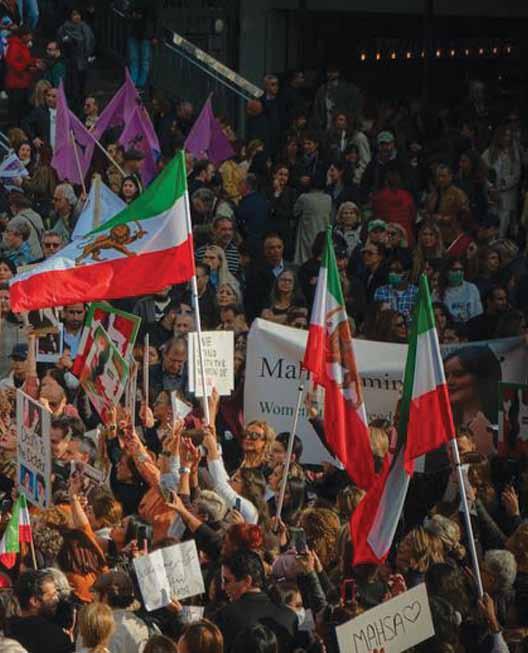
“I swear to God my son was innocent”
Koumar Daroftadeh, a Kurdish boy aged 16, was killed during protests in Piranshahr, West Azerbaijan province, on October 30 after security forces fired metal pellets at his chest and stomach from close range. The Daroftadeh family rushed to hospital in the evening of the same day. Hospital staff refused to provide them with any information and told them the office of the governor of Piranshahr would be in contact with them. Later that evening, the family met with security and intelligence officials, including personnel from the Ministry of Intelligence and the IRGC, as well as Piranshahr’s governor. The authorities told the family that they would return the body on the condition that they take an hour maximum to wash and bury their son that night. After heated objections and begging from the family, the authorities eventually allowed the family to bury the body the next morning on the condition that he is buried outside Piranshahr, 25 km from where they live!
In a video filmed during Koumar’s funeral ceremony on October 31, his father made an emotional and tearful speech, in which he said:
“The anguish I am feeling is very hard. You have not experienced it. I have been in anguish since last night but I will sacrifice my feelings for this nation and this freedom. I swear to God they will kill all of us. I swear to God my son was innocent. They [the security forces] will not have mercy on anyone.”
Since the funeral ceremony, IRGC agents have arrested and interrogated Koumar’s father several times in a bid to pressure him to publicly absolve security forces of responsibility and to attribute the killing of his son to Kurdish opposition groups.
Amnesty International released a report about Iran’s Killings of Children during Protests, describing in greater detail the unlawful killing of at least 44 children by the IslamicRevolutionary Guards Corps (IRGC).
Amnesty’s report talks of routine harassment and intimidation of the families of the murdered children. Like the Koumar family, at least 13 families of the murdered children were subjected to sustained coercion from the security forces. They threaten to withhold the bodies of the murdered children unless their families commit in writing or give media interviews in which they absolve the regime’s thugs of any responsibility. The regime places heartless restrictions on burials, such as preventing the family from holding a burial ceremony, forcing
them to bury their children in remote places or forbidding them from sharing images of their murdered children and funeral ceremonies on social media. Those who do not abide by the mullahs’ orders have been subjected to arbitrary arrests and threats to kill, torture and rape their surviving children.

Heba Morayef, Amnesty International’s Middle East and North Africa Director, said: “The authorities have not only condemned families of children killed to a lifetime of inconsolable sadness, but they have also inflicted extreme mental anguish upon them through cruel restrictions on burials and relentless intimidation aimed at enforcing silence. “
The report shows that most of the 44 victims were shot in the heart, head or other vital organs and at least five died from injuries consistent with fatal beatings. The victims include 39 boys and 5 girls, aged between 2 to 17 years old.
Mohammad Mehdi Mirshekar, a two-year old Baluchi boy, was the youngest victim and was murdered on October 2. He was standing outside his home in Zahedan, the capital city of Sistan
IRGC agents have arrested and interrogated Koumar’s father several times in a bid to pressure him to publicly absolve security forces of responsibility and attribute the killing of his son to Kurdish opposition groups
Protesters gather in Stockholm, Sweden, after the death of 22-yearold Mahsa Amini in the custody of Iran’s so-called morality police. Unsplash/ Artin Bakhan
and the Baluchestan region. He was shot in the head because the Mullahs’ gunmen were continuously firing shots randomly in all directions at a protest gathering.
The report reveals, that, at 63%, the majority of the children killed by the IRGC come from Iran’s oppressed Baluchi and Kurdish minorities, communities which have suffered for decades from systematic discrimination and persecution by the regime. Despite the fact that the IRGC have killed protesters in all of Iran’s 26 provinces, most of the reported deaths of children and adults alike occur in minority-populated provinces and cities.
A family member of a child killed in Baluchestan told Amnesty: “They did not pay any attention to us. They [Iranian authorities] do not consider us [Baluchis] human. There are many witnesses [to the killings], but their testimonies are worthless against the Islamic Republic because the authorities refuse to accept them.”
Of the 44 child victims recorded by Amnesty, 18 (40%) were Baluchi children and 10 (23%) were Kurdish children. The Hengaw Organization for
Human Rights recorded that 15 Kurdish children have been brutally killed by the regime’s lackeys. Hengaw recently released a report about the abduction of Kurdish children which identified the abduction of 130 children in Kurdish cities by the Iranian authorities. Most of the abductions were made in Sanandaj and in Seqqez, Zhina Amini’s hometown and the birthplace of the Iran Uprising.
Based on the reports received by Hengaw, some of the children were released after a period of detention but they were in such a traumatic condition they were too frightened to talk about their ordeal. For other children still being detained, there is no news on their location and status, despite their families pleading with the authorities to tell them where their children are.
“The Most Prolific Executioner of Juveniles in the World”
Even a long time before the killing of Amini, both children and adults from Iran’s ethnic minorities were disproportionately targeted for “judicially-sanctioned” executions.
Human rights advocates report that executions

have surged in Iran in the first half of 2022, doubling the total carried out during the same time span in 2021. As is known so far, 251 execution orders were carried out from January to June 2022. The Norwegian-based NGO, Iran Human Rights (IHR), reported that 27% of the people executed were members of the Baluch ethnic minority, an oppressed Sunni Muslim group that makes up just 2-6% of Iran’s total population.
The Death Penalty Information Center, an American-based NGO, writes on its homepage that “Iran is the most prolific executioner of juveniles in the world.” In a report released August 31, 2015, by the United Nations Secretary-General on the human rights situation in Iran, the U.N. expressed a grave concern “at the frequency of executions, especially for drug-related offences and of juvenile offenders.”
An Amnesty International detailed report on “Executions of Juveniles since 1990 as of March 2018,” documented 138 executions of child offenders in 9 countries. It found that the Islamic Republic of Iran “has executed more than twice as many child offenders as the other eight countries combined; Iran has executed 93 child offenders since 1990,” with the majority of the juveniles coming from ethnic minority groups.
According to a UN Human Rights report (OHCHR) dated November 24, 2021, at least 85 people remain on death row in Iran for crimes they allegedly committed as children. Here too, most of them come from ethnic minority backgrounds, with Baluchis being disproportionality represented.

Under the Islamic Penal Code of Iran, which came into force after the Islamic Revolution in 1979, the government implemented corporal punishment such as flogging, amputation and execution for a large number of offences. From drug-related offences, murder and armed robbery, to crimes falling under the category of Hodoud, meaning “crimes against God’s will,” which includes adultery by married people, rape and incest, the offenders will face the death penalty. Anyone who is found guilty of re-offending for fourth time on one of the following offences, will also face the death penalty – sex between unmarried couples, same-sex sexual relationship, drinking alcohol and prostitution. Even children have been tried and executed under Hodoud. The floggings and executions of both children and adults often occur in public, which the Mullahs regime uses as a tool to terrorize its people and normalize the use of violence under the pretext of “delivering” justice and preserving morality and order.
Another offence that can carry the death penalty is Moharebeh, which means “waging war against God,” or “enmity against God.” This is defined as the act of committing violence or rebellion against the authority of God and the state, with the intention of undermining the social order or overthrowing the regime. Human rights groups including Amnesty International have voiced their opposition and said it has been used by the Iranian authority as a tool to silence dissent. Many of those who have been charged with Moharebeh have been activists, journalists, and artists. In connection with the current nationwide protests, the Moharebeh charge has been levied against many protesters, with two young protesters recently being executed by hanging in public, namely,
The report reveals the majority of the children killed by the IRGC come from Iran’s oppressed Baluchi and Kurdish minorities, which have suffered for decades from systematic discrimination and persecution by the regime.AFP/Getty Images
Mohsen Shekari and Majidreza Rahnavard. As of December 15, 2022, Amnesty International had identified 26 protesters at risk of an imminent execution, all of whom were charged with committing Moharebeh.
On December 12, Ian Bremmer from GZERO asked the Iranian journalist and activist Masih Alinejad about the reasons why IRGC goons were so heavy-handed in the Kurdish region, saying, “They are literally murdering people and demolishing buildings (…) this is a regime known for its brutality, and clearly there is a differential response from what we are seeing in the other parts of the country, why?” Alinejad gave a direct and honest response, “The reason that the IRGC kill people in the cities of Kurdistan is because it does not get much media attention. However, it is easier to reach out to international media immediately after people are killed in Tehran, Esfahan and Shiraz. Meanwhile in Zahedan, massacres are happening. In
just one day, 70 people were killed during Friday prayers. People were shot in the back, children were killed, yet it did not get that much media attention.”
This begs to the question, how many more children need be slaughtered by the IRGC before the conscience of the world wakes up?

The security forces threaten to withhold the bodies of the murdered children unless their families commit in writing or give media interviews in which they absolve the regime’s thugs of any responsibility.By Lara El-Sayed
Amidst all the crises wreaking havoc on Lebanon as the year end approaches with many complications – from the presidential vacuum to the
demands for holding an international conference on Lebanon – the recent attack that took place in al-Aqbieh in southern Lebanon against United Nations Interim Force in Lebanon (UNIFIL) forces has caused a “more severe” and non-ne-

gotiable problem. In reaction, it seems that there is an international sense of assertiveness that the incident should not be swept under the carpet and that the perpetrators should be identified and held accountable. There have also been calls for unraveling the motives of a crime that claimed the life of an Irishman and left three others injured in an area under the influence of Hezbollah.
In the aftermath of the incident, there was speculation that the incident carried “booby-trapped messages” to the outside powers as well as those inside of Lebanon. All eyes are on the ongoing investigations and the anticipated consequences of the incident, which has raised fears of chaos and a deteriorating security situation. It is worth noting that this is not the first time that UNIFIL forces in the south have been attacked. However, this incident is the first of its kind in years in terms of bloodshed. The security report revealed that 27 gunshots pierced the UNIFIL vehicle from several angles, which negates the claim that the incident was “spontaneous.”
The Lebanese judiciary is handling the investigation. However, the lack of confidence in this judiciary prompted an Irish committee to interfere and follow-up the investigations after no arrests of any suspects were made. Meanwhile, the body of the Irish soldier Sean Rooney, who was killed in the incident, was transferred to his home country to be buried there, while the three wounded soldiers who were also in the vehicle are under treatment.
There is a prevailing sense of confusion in Lebanon, as officials were quick to denounce the crime and visited the UNIFIL headquarters to offer condolences, as did Hezbollah officials. The repercussions of the incident continue to unravel – the UNIFIL leadership and the Irish state, as well as all the countries affiliated with the international forces, continue to call for a transparent and rapid investigation leading to an arrest of the suspects. This in turn has impeded Hezbollah’s attempts to water down the investigation, just as it was able to do with other investigations in the party’s “statelet” that has proven its superiority over the state. Amidst all this, a question arises: “Why was not even one person among the ag-
gressors arrested? It is clear that some cameras documented the incident and the identity of the perpetrators. Additionally, will the perpetrators be handed over and therefore the Lebanese state will be able to avoid degrading its relations with other countries? Moreover, what is the way out?
Hezbollah Under Suspicion: A Dilemma!

Fingers of accusation are pointed “exclusively” at Hezbollah, which has been keen since the very first moments of the al-Aqbieh incident to disavow it and dismiss any direct responsibility. Suspicions focus on Hezbollah members insofar as they are in control of security in that area. It is not yet known if Hezbollah will hand over the perpetrators to the army for interrogation, or if it will allow their arrest in case investigations prove their involvement.
Writer and political analyst Tony Abi Najm told Majalla that, in a way, Hezbollah is acting too suspicious because it is calling for arrests. He noted that just like every other time, Hezbollah is trying to prove that it has nothing to do with the incident. However, all the Lebanese are well aware that the purpose of the so-called people or residents of the area is to cover up for the party’s actions, which does not want to take responsibility directly.
Abi Najm pointed out that “the recurring attacks on UNIFIL are always carried out under the guise of the people. Last year, as in 2005, when the international investigation committee tasked with investigating the crime of assassinating Prime Minister Rafik al-Hariri in the southern suburbs was attacked, Hezbollah used the same
The security report revealed that 27 gunshots pierced the UNIFIL vehicle from several angles, which negates the claim that the incident was “spontaneous.”Ali Hashisho | Credit: REUTERS
pretext – that it was people or residents of the area. Abi Najm added that the circulated videos showed that the UNIFIL vehicle was besieged, and when it tried to escape, it was heavily targeted with gunfire. According to security reports, 27 bullets penetrated the UNIFIL vehicle from several angles. This led to the death of the Irish soldier and the wounding of three of his mates. As a practical matter, this means in the military sense that what happened was an ambush and not

an accident. According to eyewitness accounts, there was a small vehicle, a Rapid van, chasing the UNIFIL vehicle since it took the main road until it got besieged and tried to seek help from colleagues from the international forces.
According to Abi Najm, “all of this indicates that Hezbollah places UNIFIL forces under its military surveillance, which completely contradicts Resolution 1701. It also shows that Hezbollah deals with UNIFIL forces as hostile forces, at a time when they are peacekeepers and recognized by the Lebanese state and government which renew their presence every year. Therefore, there is a double crisis. If Hezbollah treats the international forces as if they were hostile forces, which was apparent in the social media campaign waged by Hezbollah’s supporters, then how does the Lebanese government ask to renew the presence of these forces every year?”
Abi Najm asserted that all these factors confirm that Hezbollah is responsible for that crime. He noted, “There are political messages in what happened that will crystallize in the coming days
Fingers of accusation are pointed “exclusively” at Hezbollah, which has been keen since the very first moments of the al-Aqbieh incident to disavow it and dismiss any direct responsibility.The coffin of UNIFIL Pvt. Seán Rooney at his memorial procession at the Lebanese army airbase, at Beirut airport, December 2022 ,18. (AP Photo/Hussein Malla)
Lebanese soldiers stand behind a damaged UNIFIL vehicle at the scene where a peacekeeper convoy came under gunfire in the Al-Aqbiya village, south Lebanon, December 2022 ,15. (AP/ Mohammed Zaatari)

and weeks.” He also considered that “Hezbollah is entangled in this issue, and therefore getting out of it will not be easy.” There is an Irish investigation team taking part, and the Irish Minister of Defense is in the United Nations. Therefore, Hezbollah may have brought upon itself and the Lebanese state quite a bit of trouble.”
Abi Najm stressed that the problem lies in the fact that Hezbollah always seeks to impose its complete and absolute hegemony over southern Lebanon. What is funny, yet so sad, about this is how the people (as Hezbollah claims) noticed in the late hours of the night a change of the route of a UN vehicle from the international highway to another road, which is basically also an international road. They followed it and besieged it. Meanwhile, Hezbollah continues to deny knowledge of what happened in the crime of assassinating the activist Lokman Slim. This means that this ambivalence has become a reality, which indicates that virtually everything that happens in these areas is subject to Hezbollah’s surveillance.
With respect to linking the incident to the
President’s
holidays
oil and gas agenda, Abi Najm indicated, “There are several scenarios and messages playing out. What is certain is that sometimes the organizer may have a specific message but the results end up taking him to different outcomes than those originally planned. This is what the coming days will reveal. The tables were turned, just as it happened when Prime Minister Rafik Hariri was assassinated, which was a crime against a person of great magnitude in Lebanon and the region. As a consequence, the Syrian army left Lebanon and an international tribunal was formed against Hezbollah and so on. This means that regardless of the goals behind the message, the results are sometimes in a totally different and much complicated place. The repercussions in this case will be related to the way of dealing with the investigation. If Hezbollah thinks that it can protect the criminals and decides not to cooperate with the investigation and does not hand over the shooters whose names are known, then the international repercussions will be of great magnitude.”
Abi Najm stressed that “the state is obligated, as are the government and the institutions concerned with extraditing the wanted persons. The official investigation now has the names of the shooters and the video clips are clear. Therefore in the event that Hezbollah refuses to cooperate with the investigation, it will face a very big dilemma. If it cooperates and the perpetrators surrender, it will face a double problem – firstly, there will be proof of its responsibility in the crime and secondly, it will be forced for the first time to hand over suspects from its own group and its own environment, which means that the possible scenarios are many.”
‘Intentional’ Crime – State is the Greatest Absentee There is a great deal of anticipation as to what
the incident will bring about, knowing that it brought Lebanon to a new impasse that will be added to the series of crises besieging it at all levels. The incident took place during a very sensitive period and the consequences will be heavy if not handled well, according to political writer and analyst Ali Hamada. He told Majalla that “one can confidently say that the crime that took place in the southern town of Al- Aqbieh and targeted a patrol of the Irish UNIFIL forces was planned and premeditated.” He pointed out that “it is clear that the crime was committed on the basis of a command decision, and the orders to fire on the patrol were given to personnel who clearly came from Hezbollah and the so-called ‘people or residents of the area,’ who themselves are practically armed factions affiliated with Hezbollah and subservient to it.”

According to Hamadeh, “the dangerous thing is that this attack in this bloody manner is the first of its kind. During the past years, there were attacks by the so-called residents on the patrols of the international forces when they were trying to carry out monitoring or verification of certain violations of Resolution 1701.”
Hamada explained that “this time, a decision
“What is so worrying about all of this is the stance of the Lebanese state, emerging as the greatest absentee in this context.”An armored UNIFIL personnel carrier is pictured next to a large poster of Iran’s Ayatollah Ruhollah Khomeini as it patrols along a road in southern Lebanese towns, Nov. 2021 ,11. (AFP)
UNIFIL
Aroldo Lazaro Saenz (second right), visiting the UNIFIL headquarters in the southern Lebanese town of Naqoura, on December 2022 ,16, a day

was made to resort to bloodshed and premeditated killing.” The Security Council has the right to carry out periodic work and to investigate and verify that Resolution 1701 has not been violated without needing permission from any party whatsoever, whether it is the official Lebanese party or any unofficial Lebanese party. He recalled that Hezbollah Secretary-General Hassan Nasrallah recently warned that matters in this regard would escalate.
What happened, according to Hamadeh, “is not an ordinary message, but much more than that. It is a decision to move the relationship between Hezbollah and the international forces in southern Lebanon from the stage of preserving peace to the stage of bloody confrontation against the tasks of these forces.” He added: “What is so worrying about all of this is the stance of the Lebanese state, emerging as the greatest absentee in this context. The Lebanese official political surrender is especially vivid inasmuch as it was content with a general condemnation and condolences without holding anyone responsible.”
Hamadeh stressed, “Hezbollah is responsible for the killing of the Irish soldier, and it essen-
tially does not want to hide its responsibility in this crime. The propaganda machine of Hezbollah is relentlessly working to justify this crime. Moreover, the investigations so far indicate for sure that the patrol was chased and fired at directly. There are even eyewitnesses who say that the Irish soldier was killed deliberately and at close range.”
Hamadeh concluded by emphasizing that “in any case, the issue is not related to Hezbollah’s responsibility, which is known, as much as it is related to the stance of the Lebanese state, the Lebanese official authorities, and the Lebanese political forces surrendering to Hezbollah’s arms and power, knowing that their interests meet at the local level.”
All indications suggest that the incident will bring about some changes. The bet remains on how those concerned will deal with the new reality in light of the absence of a head of the state and unprecedented state of confusion taking its toll on the country, mainly due to the political vacuum and the failure of any faction to accept civic responsibilities. All of this may pave the way for chaos to wreak more havoc on Lebanon and bring about unwanted consequences.
Lebanon’s caretaker Prime Minister Najib Mikati (right) accompanied by the Head of Mission and Force Commander of the United Nations Interim Force in Lebanon (UNIFIL) after an Irish soldier was killed in the region.With the sunset of December 31st, 2022, a year will come to an end after it witnessed many events and crises, the most notable of which was the RussianUkrainian war in February 2022, and the ongoing
ramifications of the COVID- 19 pandemic, which is still present today, with the world still facing a challenge similar to what China is facing today.
This year also saw the holding of numerous global and regional summits and meetings, marking the first time since the turn of the millennium that
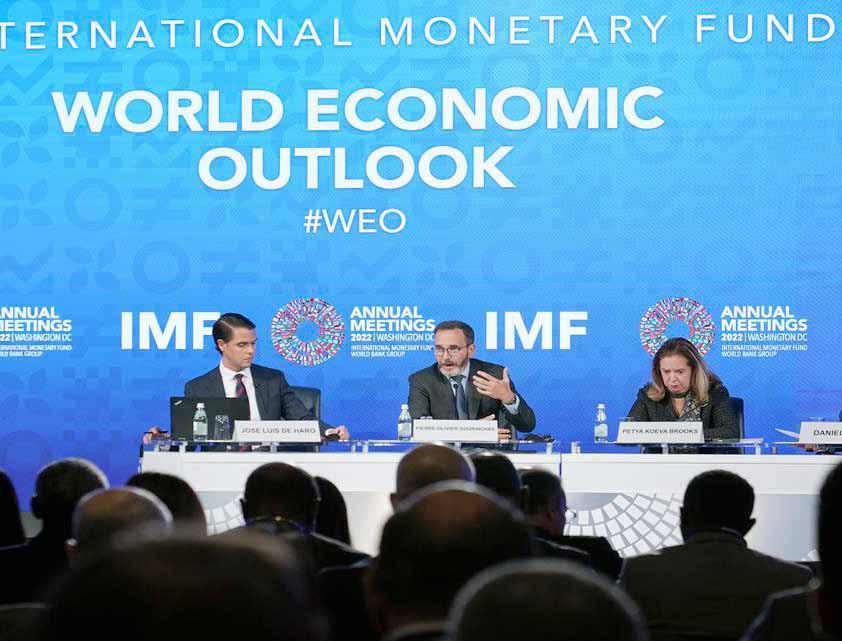
Pierre-Olivier Gourinchas, economic counsellor and director of the research department at the International Monetary Fund (IMF), second left, speaks during a World Economic Outlook news conference during the annual meetings of the IMF and World Bank Group in Washington, DC, U.S.A., on October 2022 ,11. (AP)
one year has seen such an unprecedented number of international summits. It began with the African-European Summit in February, the Jeddah Security and Development Summit 2022 in July, the Eighth Tokyo International Conference on African Development (TICAD 8) in August, the World Economic Forum in September, the Samarkand Summit of the Shanghai Cooperation Organization (SCO) in September, and the International Climate Summit (COP 27) in November, leading up to the three summits in December that brought Chinese President Xi Jinping together with the leaders of Saudi Arabia and the rest of the Gulf Cooperation Council countries, as well as many Arab leaders, and concluding with the American-African Summit. The year was marked by significant transformations that signaled a shift in the international system toward multipolar world.
It will be reflected by the situation in various regional countries, which will undoubtedly become places of competing international poles in efforts to gain more areas of influence and form more alliances. Aspirations and hopes were carried at these summits in order to face challenges and crises and reach proposed solutions to enter the new year (2023) with new paths at various levels –political, economic, security, and military, which open the door to searching for possible expectations for the new year.

It is true that the current circumstances, as complex and entangled as they are, make the forecast of expectations a very difficult and challenging process, even if they relied on complex mathematical models, because the world is experiencing unprecedented excessive crises.
As the Danish physicist and Nobel Prize winner Niels Henrik David Bohr said, “Prediction is very difficult, especially if it is about the future.”
The Organization for Economic Cooperation and Development (OECD) agreed with him in a recent report stating that “substantial uncertainty surrounding the economic outlook,” particularly with the threat of a winter energy shortage and the sharp rise in prices, threatens the operations of an increasing number of companies, some of which have been forced to reduce their activities. However, despite all of these challenges, many research centers, thinkers, and specialized scholars presented their expectations and possibilities
for what the world might witness over the next year, which we may observe in the following categories:
Many people predicted that the coming year would see an increase in political tensions between world powers, with polarizations and divisions between countries, particularly the major ones (Russia and China, on the one hand, and the United States and its allies, in NATO or newly formed alliances such as QUAD, on the other). These divisions would also extend to different regions, as conflicts between regional powers are expected to intensify as a reflection of global tensions, implying that the global political scene will undergo significant changes, bolstered by the rise of new leaders in power who challenge existing alliances.
It is true that regional countries are attempting to find a way to survive in this highly intertwined and complex world, which is dominated by a state of uncertainty regarding future political paths, portending more instability, perhaps not just next year, but for the rest of the decade.
This is exacerbated by the internal crises and political divisions that many countries, particularly those labelled as “developed,” have experienced as a result of the rise of extremist political tendencies such as populism and nationalism, as well as the resulting domestic political conflicts over many of the most pressing issues on these countries’ agendas, particularly migration and
This year also saw the holding of numerous global and regional summits and meetings, marking the first time since the turn of the millennium that one year has seen such an unprecedented number of international summits.
climate change.
On the military level, the Russian-Ukrainian military crisis, which has entered its tenth month, is expected to continue, and its future path remains ambiguous in light of either side’s inability to resolve the battle in its favor, despite Russia’s perceived expectations at the beginning of the conflict. Consequently, this will lead to increased global tensions and an exacerbation of the number
of regional conflicts, as well as the continuation of internal conflicts in many developing countries, particularly in the Middle East and the African continent.

The global and regional picture being bleak, there is still a light at the end of the tunnel carried by some countries in their efforts to preserve what remains of security and stability on the one hand, and to assist developing countries on the other. This is the position of some regional countries whose status has risen globally and regionally, led by the Kingdom of Saudi Arabia, Egypt, and the UAE, as these three countries play critical global and regional roles in attempting to deconstruct many crises and find effective solutions that contribute to mitigating their consequences.
The annual report of the United Nations Conference on Trade and Development (UNCTAD), issued at the end of this year 2022, presented a deep and comprehensive reading of the global economy outlook this year. There are three important observations contained in the report that can be useful in anticipating the future. The first is that the an-
The IIF also points out that the challenges mentioned in forecasts by senior economists require national leaders and policymakers to strike a balance in order to reduce any potential negative consequences.
nual growth rate in merchandise trade activities in 2022 was around 13.8%, which is significantly lower than the rate of around 26.5% in 2021. Furthermore, despite a 14.6% growth rate in services trade, it has yet to reach pre-pandemic levels.
The second point is that, despite an increase in developing economies’ trade surpluses, particularly those on the African continent, diversification of exports remains the main challenge and major obstacle confronting these economies, with the geographical region of West Asia and North Africa serving as the focal point of this development problem.
Third, the gap between the growth achieved in the global economy in 2022 and the growth targeted in the United Nations Sustainable Development Plan for 2030 has widened. While global GDP growth reached about 5.7% in 2021, owing to pandemic economic recovery programs, the maximum of what the global economy could achieve by the end of the current year 2022 did not exceed a rate of 3.3%.
There is no doubt that these three observations are main inputs to where economic conditions will lead in the coming year, as stated in the report published on the World Economic Forum (WEF)
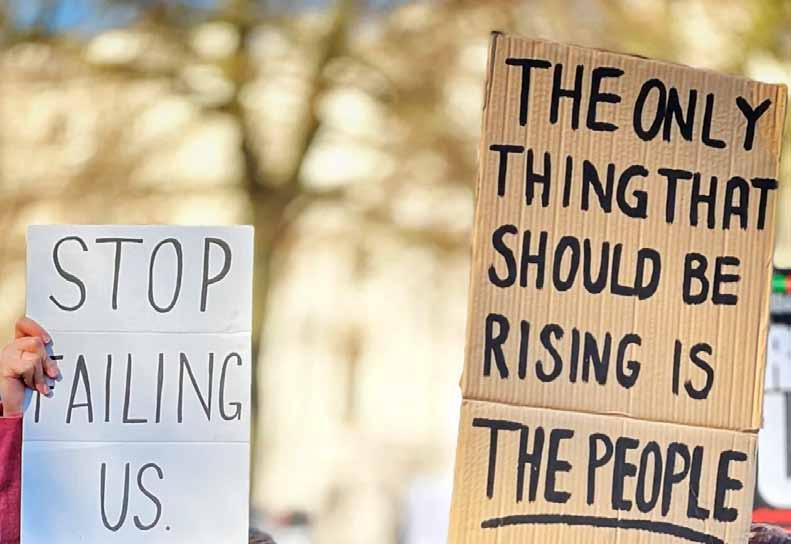
website, entitled “Expectations of Senior Economists for the Future of the Global Economy.” The report stated that expectations revolve around a rise in the rate of inflation, a decrease in real wages around the world, as well as a deterioration of food security, particularly in developing economies. This comes in line with the expectations of the Institute of International Finance (IIF), which believes that the global economic growth rate will reach 1.2% in 2023, a level equivalent to 2009, when the world was just emerging from the financial crisis. The IIF also points out that the challenges mentioned in forecasts by senior economists require national leaders and policymakers to strike a balance in order to reduce any potential negative consequences, whether through complex budgets of monetary policies, or setting priorities, particularly with regard to food and energy security, and balancing national priorities and global goals.
All of this suggests that economic conditions will deteriorate further, particularly in terms of international debt. One of the most prominent expectations is aggravation of foreign debt, particularly in emerging and developing market economies and in poor countries. This, in turn, raises the risk
of global financial instability, slowing economic growth, and causing financial market turmoil in these emerging economies, in addition to numerous negative political and economic ramifications. These expectations are consistent with what was stated in the book of the French economist Nouriel Roubini titled Mega Threats where he mentioned

ten general trends and dangerous phenomena, the foremost of which is the international debt which he described as “The Mother of All Debt Crises.” The list included demographic challenges, stagflation, government and private sector dysfunction, currency collapse and financial turmoil, the end of globalization, artificial intelligence, and the new Cold War. The list also mentioned the climate crisis.
The International Monetary Fund’s economic counsellor, Pierre-Olivier Gourinchas, confirmed the same trends in a blog that accompanied the release of the Fund’s latest “Global Economic Outlook” report. He wrote, “One-third of the global economy are poised to contract this year or next. The three largest economies, the United States, China, and the euro area will continue to stall. Overall, this year’s shocks will re-open economic wounds that were only partially healed post-pandemic. In short, the worst is yet to come and, for many people, 2023 will feel like a recession.”
There are continuous efforts to confront climate
At that point, the national state will face an existential crisis if it is unable to quickly tackle these circumstances, correct these imbalances, and deal competently with all transformations and developments.A protester in Parliament Square earlier this year demanding government action. (Belinda Jiao/SOPA Images/LightRocket via Getty Images)
change and reach an international agreement to implement previous commitments of reducing greenhouse gas emissions, keeping the rise of earth’s temperature at about 1.5 degrees Celsius, and reaching net zero, in addition to the commitment of developed and developing countries to build climate resilience and adaptation.
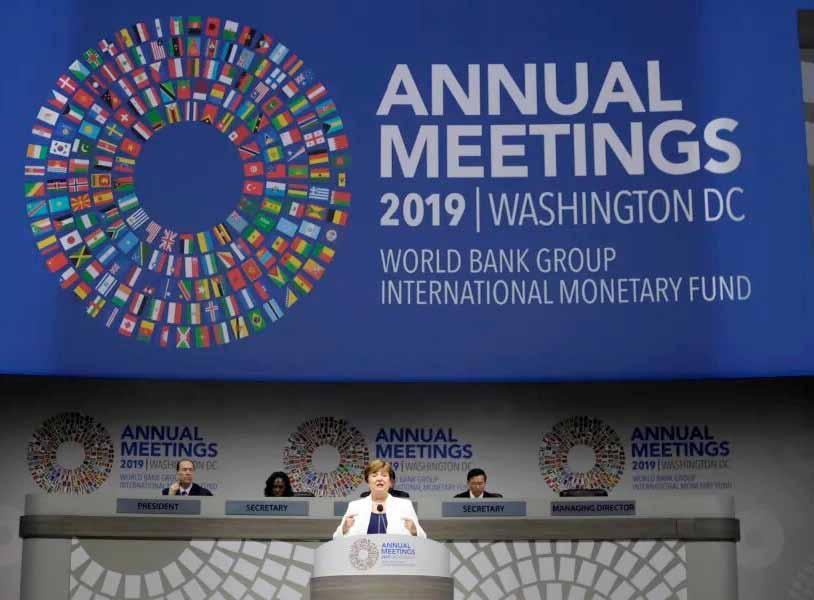
However, the world will continue to face climate challenges as global warming worsens. In this regard, it would suffice to refer to the British environmentalist Gaia Vince’s book Nomad Century: How to Survive the Climate Upheaval. Vince warns that climate change will cause an increase in climate migration and asylum seekers from the hotter southern regions of Asia, Africa, and Latin America to the countries of the north, which must prepare for unprecedented human flows of climate refugees as long as climate-harmful emissions continue in their current patterns without a radical reduction.
To conclude, in light of the previously mentioned difficulties in drawing courses of action,
there is a need for decision-making institutions in our Arab world to carry out two basic tasks, if they want to prepare for what is to come. The first is to rely on actual, realistic data and detailed information that is constantly updated for their plans to be consistent with real challenges and not yield to aspirations and hopes that are far from the current reality and challenges.
The second task, also related to the first, is to have, in light of the plans and policies they develop, alternative scenarios with a high degree of flexibility to deal with urgent and unexpected changes. This can only be possible if they have research centers capable of tracking major political and economic developments, as well as trends, and explore their impact on daily issues and interests. Otherwise, these institutions will be unable to face the expected and unexpected shocks. At that point, the national state will face an existential crisis if it fails to quickly tackle these circumstances, correct the imbalances, and deal competently with all transformations and developments.

President Xi Jinping made his vision quite clear – he sees the future of China as a power with a significant role in shaping international politics and trade. This motive, which it shares with many of the other global powers, determines many of the strategies and tactics used by China. One of the main ways it is achieving its goals is by strengthening political and economic relations with the global south, particularly with the Belt and Road Initiative and the Global Development Initiative. Although this topic has been discussed numerous times, this article will explore whether both initiatives are going anywhere.
The Belt and Road Initiative focuses primarily on establishing and developing the physical infrastructure for trade routes connecting many countries. The Global Development Initiative “aims to support developing countries in poverty alleviation, public health, and other issues” and is achieved through grants and capacity building. Of course, this is not done out of pure altruism, as with any political initiative. Not only would both initiatives increase the weight and role of China as a global power, but also ripen great economic returns. For instance, if we take China›s engagement with many resource-rich African and Latin American countries with poor infrastructure, extending finance ensures that Chinese companies will be called on for extraction.
Of course, this tactic of financing in return for securing natural resource rights and other benefits is not the
invention of China. As Yun Sun from the Brookings think tank states, “… commodity-backed loans were not created by China – leading Western banks were making such loans to African countries, including Angola and Ghana, before China Exim Bank and Angola completed their first oil-backed loan in March 2004.” The evidence that China finances projects in return for natural resource rights is quite clear and the Brookings report cites many instances. Here are a few: “In 2010, Sinopec’s acquisition of a 50 per cent stake in Block 18 coincided with the disbursement of the first tranche of Exim Bank funding, and in 2005, Sinopec’s acquisition of rights to Block 80/3 coincided with the announcement of a new USD 2 billion loan from China Exim Bank to the Angolan government.”
However, as stated by Dr Yu Jie, China›s recent aggressive lending model has been reduced to defend its strategic interests and create a global reputation of being a reliable partner rather than a fierce predator. In addition, spending on both initiatives has been reduced as China is facing a domestic economic slowdown.
For China to achieve what it wants, it will have to focus on robust development and infrastructure initiatives rather than financial investment conditional on business. An initiative that alleviates poverty and is tailored to the benefit of all the countries involved can help China be this brotherly figure for the global south.
For China to achieve what it wants, it will have to focus on robust development and infrastructure initiatives rather than financial investment conditional on business


On December 12, oil giant Saudi Aramco and the government-owned Kuwait Gulf oil company signed a deal to develop the Durrah gas field, which is located in the Arabian Gulf, with a production of 1 billion cubic meters a day. The Saudi-Kuwaiti move comes with another side of the story on
the other side of the Gulf. Iran claims it has ownership rights over parts of the Durrah gas field and calls it Arash. This introduction is not meant to tell a story about the gas conflict between neighboring countries, especially if we know that there has been a continuous dispute over Durrah since the 1960s, i.e., pre-Islamic Revolution in Iran. What is meant is the highlighting of the emergence of gas in the global energy
scene. The rule says that whenever there is a conflict, there is a big reward expected at some point.
“Saudis and Iranians have a reputation for their ability to reach settlements and deal with different issues separately. They could be fighting somewhere in Yemen but cooperating in the Hajj and Umra season in the Holy Cities of Makkah and Madinah. When there is no agreement, Iranian pilgrims will not be able to perform the Hajj, the fifth pillar of Islam,” Arab observer Mahmoud Ayham told Majalla.
“Europe intends to replace Russian gas with supplies from the Middle East, especially east Mediterranean and GCC. Qatar supplies around a quarter of the gas consumed in the UK. Qataris have agreements with Iran over shared gas fields,” he added. What is the story of Saudi natural gas?
Since the beginning of the mass production of oil in Saudi Arabia in the early 1930s, the Kingdom did not benefit from the accompanying gas (methane and others).
The Saudi Aramco website says: “We’ve been capturing and using gas as a way to generate additional value streams beyond crude oil since the mid-1970s. Today, we are the sole supplier of natural gas to Saudi Arabia, the seventh largest natural gas market in the world.”
This means that the Saudi energy makers have realized the importance of gas as a cleaner source of energy, which can sustain a variety of industries.
The Saudi energy giant mentions the industries that benefit from gas: “Our natural gas is a fundamental product used to meet growing domestic energy demand to power industries such as steel, aluminum, and water desalination. It provides an efficient, cleaner burning energy alternative for these activities which helps lower emissions.”
The Saudi gas mix includes ethane, natural gas liquids (NGL) and condensate.

“Saudi is self-sufficient now with a production of 120.5 billion cubic meters annually. It is not a secret that Saudis want to free up as much oil as they can and boost their gas production capacity, replacing oil with gas to increase oil exportation capabilities. This is part of the Saudi energy transformation of the Kingdom Vision 2030,” commented Ayham on the rising local need for gas.
In his book “Out of the Desert: My Journey from No-
madic Bedouin to the Heart of Global Oil,” ex-Saudi Oil Minister, Eng. Ali Al-Naimi, mentions that he was not convinced of investment in gas. That’s why marathon discussions with energy conglomerates failed. Kingdom Vision 2030 bets on natural gas to diversify and expand the Saudi energy mix. Saudi aims to be the world’s third gas producer with a priority for local industries.
“Saudi believes there is a shift in the gas market. The US is replacing the Russian gas with its gas that is being exported to the EU at five times the regular price of Russian gas. The Europeans are forced to do so. However, they want more supplies from other markets. Saudi Arabia has discovered 7 oil fields since the beginning of 2022. The explorations are going ahead. Surprises are expected on the way,” explains the expert Ayham on the current situation of the gas market.
Saudi has pledged to reach net zero by 2060. On the way to 2060, other alternatives of oil should replace it. Gas, a less pollutant source of energy, helps with the Saudi plans to limit the emissions that may lead to higher temperatures.
Gas is cheaper than oil, but does not have the benefit of easy transportation as oil does. Special pipes or liquefaction are the only ways of moving gas from one place to another. This means that the expansion of gas production facilities is crucial in the energy transformation of the Kingdom.
“Gas is an obligatory path for a better environment condition in the Kingdom,” concluded Ayham.
“Saudi is self-sufficient now with a production of 120.5 billion cubic meters annually. Saudis want to free up as much oil as they can and boost their gas production capacity.”
The recent book published last month by former American First Lady, Michelle Obama, “The Light We Carry: Overcoming in Uncertain Times,” could have been named “The Hair We Carry,» because of the intense interest in what she wrote in the book about her hair, even though there was not much discussion of this topic.
As may be expected, during these years of heavy debate in the U.S. about Black-White relations, which has recently branched into a debate about Black hair, Obama’s writing about her hair became a major issue. Headlines in major American newspapers and magazines that reviewed the book were mostly about the subject: The Washington Post: “Michelle Obama says America was not ready for her braids.”
The Hill (In Washington): “Michelle Obama says she had to ease the nation into a first lady with Black hair.”
National Review: “Michelle Obama Says Americans Were ‘Not Ready’ for Her Natural Hair.”
A book that coincided with the publication date of Obama’s book was written by her hair-stylist when she was in the White House, and was titled: “Natural & Curly Hair for Dummies,” which elaborated on Black hair history, texture and care.
In her book, Obama wrote that she considered wearing her hair in African braids while in the White House, but was afraid of being rejected by many Americans with stereotypical views. She said the Americans were “just getting adjusted” to having a Black president and a Black family in the White House. But, “nope, they’re not ready for” African braided hair.
Hair or no hair, she wrote: “For eight years as First Lady, I’d been vigilant and cautious, deeply aware that Barack and I and our two daughters had the eyes of the nation upon us, and that as Black people in a historically white house, we could not afford a single screw-up.”
She added, “I had to make sure I was using my platform to make a meaningful difference, that the issues I worked on were well-executed and also complemented the president’s agenda. I had to protect our kids and help them live with a small level of normalcy, and support Barack as he carried what sometimes felt like the weight of the world.” Obama related her hair experiences to those of other Black women as they navigated the politics and sensibilities of their workplaces. Although preferring what she described as easier, healthier and safer braids, dreadlocks or Afros, she said she felt the pressure from White beauty standards and workplace norms to chemically straighten her hair for a more professional, “clean-cut” appearance. “We deal with it, the whole thing about, ‘Do you show up with your natural hair?’” Obama said.
Some American commentators criticized this post-George Floyd obsession with Black hair, in reference to the Black
Book: “The Light We Carry: Overcoming in Uncertain Times”
Author: Michelle Obama
Publisher: Crown, New York Paper Pages: 336 Paper: $16.89 Electronic: $16.99
man who was killed in Minnesota by a White policeman in 2020 – the killing that ignited the current intense debate about Black-White relations.
This obsession reached the Congress.
Earlier this year the House of Representatives debated Black hairstyles, such as braids and dread, and passed the Crown Act Bill to prohibit discrimination based on someone’s hairstyle, including those “in which hair is tightly coiled or tightly curled, locs, cornrows, twists, braids, Bantu knots, and Afros.”
During the debate a Republican Congressman wondered: “Instead of arguing about sending weapons to Ukraine, here we are arguing about women’s hair styles.” The bill was blocked in the Senate, but now with the Senate controlled by the Democrats, the Senate is expected to pass it.
During the debates in the Congress and during Obama’s own book tour, the subject was engulfed in sensitivities, not only because it involves women’s beauty standards, but also because of the historically difficult relations between Blacks and Whites, and particularly the history of Black women’s relations with Whites – both men and women.
Recently, there have been a few news items about the subject, although most of the time the topic was blown-out of proportion because of the intensity of the debate:
In 2018, a -6year-old Black boy was blocked from attending school because he wore his locks below his ears. In 2019, a Black TV reporter said her director told her that her natural hair was “unprofessional” and pressured her to change it to “what looks best.” And in 2020, a Black job applicant complained that she was told to have her hair in a “clear-
cut” style.
The current book tour by Obama, popular and attended by mostly multi-racial women, sometimes heats up on the subject of Black hair.

During an interview with famous TV personality Ellen DeGeneres, Obama quoted some of her critics saying: “Remember when she wore braids? Those are terrorist braids! Those are revolutionary braids.” Obama, wearing braids during the interview, grabbed her hair and shouted: “Braids, y’all!” to applause from the crowd.
Michelle Obama, more than her husband, former president Barack Obama, has had critical relations with Whites if for no other reason than that the husband is half-White and half-Black. Although the husband, from early on, identified himself as a Black, he has been at ease with Whites, not only because his mother was White, but also, because he was reared by her White parents.
The wife’s tense relations with Whites were documented in her own thesis when she graduated from Princeton University in 1985
She wrote in the introduction: “My experiences at Princeton have made me far more aware of my ‘blackness’ than ever before … I have found that at Princeton, no matter how liberal and open-minded some of my white professors and classmates try to be toward me, I sometimes feel like a visitor on campus; as if I really don’t belong. Regardless of the circumstances under which I interact with whites at Princeton, it often seems as if, to them, I will always be black first and a student second.”
In the thesis, titled “Princeton-Educated Blacks and the Black Community,” Obama wrote about a future of “further integration and/or assimilation into a white cultural and social structure that will only allow me to remain on the periphery of society; never becoming a full participant.”
Well, Obama now is not «on the periphery” and is a “full participant.”
During the current heavy debate in the U.S. about BlackWhite relations, which has recently branched into a debate about Black hair, Obama’s writing about her hair became a major issue.
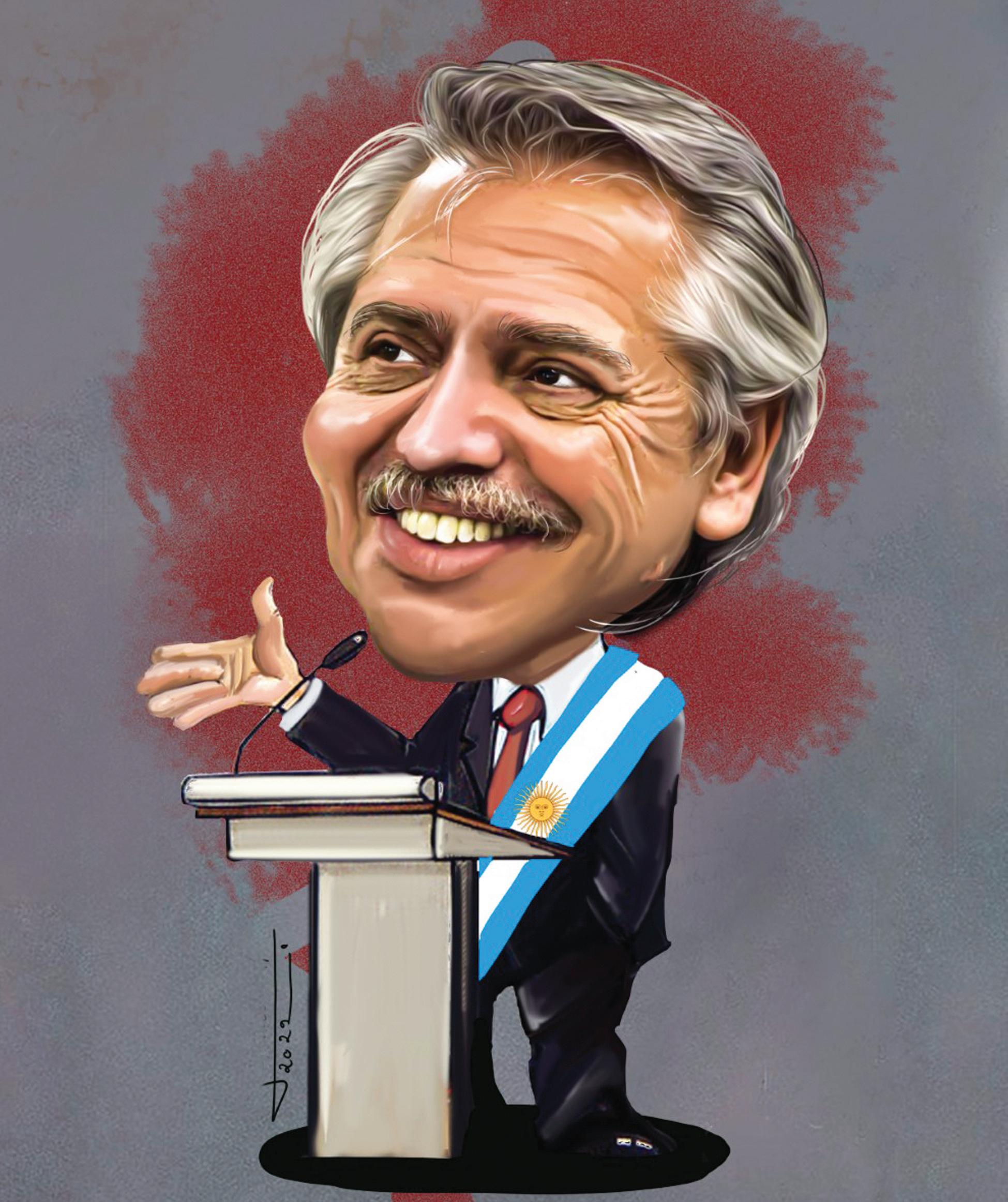

In the perishing cold of January 1632, a petty thief by the name of Aris Kindt was hanged in Amsterdam. In this more enlightened age, it is hard to imagine a death sentence for theft. Back then, it was probably so commonplace – the crime and the punishment – that no one took much notice, and the name of Aris Kindt would have been forgotten almost immediately, except by whomsoever had loved him. But the unfortunate Kindt had, at least from the point of view of posterity, the good fortune to die in the depths of winter. This was the time of year that had inspired Francis Bacon to experiment with refrigeration. He tried the technique on a chicken, before catching the chill that killed him. For similar reasons, the depths of winter were a time for public dissections. If you belonged to the highest ranks of Dutch society and could pay the right money, you could attend these dissections in the Waaggebouw, a building that can still be seen in Amsterdam.
On the day Aris Kindt died – in fact, within an hour of his demise – one such dissection was scheduled to occur. It was hosted by the Guild of Surgeons and

presided over by a certain Dr Nicolas Tulp. We have pictorial evidence that this happened, provided by one of the world’s most celebrated artists, who had been commissioned by the Guild to show the good doctors in their best attire and surrounding the corpse of the malefactor, as they hear Dr Tulp explain the inner structures of the arm and hand. Specifically, Kindt’s arm and hand, which have been carefully flayed to reveal the tendons, nerves and blood vessels that make up the mechanism.
There is something apt about this part of the body being the one the surgeons examined first: the deceased was a thief, after all. For the sake of consistency, we must assume that he was left-handed. However, as W.G. Sebald points out in The Rings of Saturn, the choice of this part of the body to start a dissection was unorthodox. Dissections would customarily begin with the intestines, as these parts were the most prone to putrefaction. And there is a further curiosity in the painting: if we look closely at the thief’s arm, it is anatomically incorrect.
As Sebald points out: ‘…the exposed tendons, which ought to be those of the left palm, given the position of the thumb, are in fact those of the back of the right hand.’
A hint as to why this may be the case lies in the direction of the surgeons’ gaze, for they are not looking at the body of the hanged man, as one might expect, but past it, towards a large book opened, presumably, on the page depicting the human arm. This is the same source the artist appears to have drawn upon.
Sebald continues:
‘It seems inconceivable that we are faced here by an unfortunate blunder. Rather, I believe there was deliberate intent behind this flaw in the composition. That unshapely hand signifies the violence that has been done to Aris Kindt. It is with him, the victim, and not the Guild… that the painter identifies… He alone sees that greenish annihilated body, and he alone sees the shadow in the half-open mouth and over the dead man’s eyes.’
The painting is intent on showing us what people can see or, in this instance, what they can be conditioned not to see. In a sense, ‘it is debatable whether anyone ever really saw that body, since the art of anatomy, then in its infancy, was not least a way of making the reprobate body invisible.’ The body is in plain sight and yet, like Poe’s purloined letter, it escapes the attention of the surgeons. In addition to indifference, a kind of veil has been cast over the body, which
Sebald mysteriously compares to fog, interposing itself between the living persons and a fellow mortal. As a consequence, the artist has to do the seeing for them, by identifying with the victim in a way they cannot, since how would the surgeons and the paying members of the public retain their composure, or be able to stomach the scene at all, whether out of simple human pity or squeamish revulsion, without some degree of detachment? Science cannot see the same things as art. The doctors of science cannot address the obvious horror in front of them. Thus Kindt, the hapless object of scientific enquiry, is also the (dead) elephant in the room. This passage displays a habit of mind in Sebald, that of wishing to restore visibility to those obliterated by violence. It is also a meditation on the past and its ghosts. Through this painting, the petty thief is immortalised just as surely as the doctors. The painting came, after all, from the hand of Rembrandt, who one assumes was there in the room, not with his easel as such, but at least attending the lesson. Surprisingly, Sebald is convinced (‘so it is said’) that the philosopher and amateur anatomist, René Descartes, was also present. We can even speculate that Sir Thomas Browne, later a revered inhabitant of Norwich, was among the spectators. He was studying medicine in Leiden at the time. We can’t see these or any of the other attendees because, like Rembrandt, they are where the viewer of the painting is positioned. The possibility, nonetheless, is that these three men were in attendance, and that they were entirely ignorant of the significance of the others. Browne himself may have rubbed shoulders with a dishevelled chap who he had no way of recognising as the greatest artist of his age…
…while at his other shoulder sat a man who, in Sebald’s words, taught that ‘one should disregard the flesh, which is beyond our comprehension, and attend to the machine within.’ It is unlikely that many physicians ever succumb to the Cartesian way of thinking.


Like a very old photograph, this painting depicts more than one dead man: nine dead men are visible. Furthermore, alongside ourselves as we view the picture stand the ghosts of Sir Thomas, a man best known for his reflections on death; a French philosopher, who might be said to have been there and yet not been physically present, reduced as he was to the cogito; and an unkempt painter who had no special interest in anatomy, who may well have found the scene
morally and physically repugnant and, if Sebald is to be believed, was alone in feeling the slightest sympathy for the poor fellow whose arm they had just assaulted.
Doctors, writers, artists and thieves all work with their hands, but that does not imply a feeling of kinship with each other. I suppose the doctors can be forgiven, though. As members of the caring profession, once the patient has passed on, they’re past caring. One can dispense with the Hippocratic oath and hand everything over to the undertaker. Besides, as we shall see, these are not normal, healthy doctors; one could say they are sicklied over with the pale cast of thought, or perhaps that only goes for the English one in the audience. The sympathy on Rembrandt’s part is Sebald’s projection, of course, just as surely as it is his proposition that the three men were there, in the same room. It can readily be doubted that Rembrandt felt such things. If Descartes is right, it can only be said for certain that he thought and, therefore, was. We are left with a tantalising possibility that he felt in his own body the suffering of Kindt’s, but we can never truly know. Nor, of course, can we be sure that Browne was there, or ‘from which angle… he watched the dissection… or indeed what he might have seen there.’ This issue of the angle of Browne’s vision is enigmatic. Perhaps more to the point, though, how much he might have seen is in question, because there was another thing that could get in the way of clarity, something Sebald finds described in Browne as a ‘great fog’ that briefly covered England, which then morphs (such are the digressions in both Browne and Sebald) into a white mist that rises ‘from within a body opened presently after death, and which during our lifetime, so he adds, clouds our brain when asleep and dreaming.’
What this white mist means I cannot confirm, as I have been unable to find the relevant passage. I could feel a pang of guilt about this, were it not that Sebald himself, on one occasion, when alluding to Browne’s reference to the use of black Mantua silk in Holland, admits it appears ‘in a passage … I can no longer find.’ He recalls it was used to cover mirrors and landscapes, so that the souls of the dead would not be tempted to linger in the room. There is little in this particular room to detain Kindt’s soul.
In some weird way, the appearance here of the mist dims even further the clear eyes of science. The surgeons, oblivious to the body, absorbed in the illustrations of a book, are further rendered purblind by this mist emanating like miasma from the corpse. It forms an envelope around the body, cutting it off, shielding it from the intrusive eye and preventing it from renewed violation. This strange brain fog closes in on Browne as he attempts to perceive the inner workings of what he calls our ‘nature’. Like Descartes, he sees the body as opaque, but while the French philosopher chose to bracket out the flesh altogether, Browne tried to supplement his science with esoteric knowledge, as Paracelsus (whom he admired) had done, and with religion. None of this was calculated to dispel melancholy, and perhaps it was the predominance of this very seventeenth century humour that ultimately held Browne back, prevent-
Science cannot see the same things as art. The doctors of science cannot address the obvious horror in front of them.Rembrandt’s ‘Self-portrait with dishevelled hair’ René Descartes. ‘Cogito, ergo sum’
ing him from making any medical breakthroughs. Instead, melancholy tempted him into reflections of a kind taboo among men of science. Not only did he revere Paracelsus, but he expended precious midnight oil on the musings of Hermes Trismegistus, say, or the obscurities of the Kabbala. A man with such pseudoscientific interests was unlikely to discover refrigeration by burying a chicken in a snow drift. He would have been more inclined to expatiate on the untimely passing of the chicken. While a good doctor has no business thinking about death, Browne – a bad doctor – could never cure himself of the habit. In the end it was melancholy, and not the emanations of a corpse, that turned out to be miasmic.
even heard of the sprawling Anatomy of Melancholy, nor have many dabbled in the complete works of Sir Thomas Browne. He richly deserves, nonetheless, pride of place in the illustrious company of England’s melancholics. Sebald admired how he wrote ‘out of the fullness of his erudition’ and gave us ‘sentences that resemble processions or a funeral cortège in their sheer ceremonial lavishness.’ Coming from a writer who created a sentence several pages long in Austerlitz, this sounds like the commendation of an apprentice.
For old time’s sake, having admired Browne in my youth, I ventured back into his baroque prose. I confess I cheated a bit, though; I read somewhere that Urn Burial reached its sublime climax in Chapter V and stuck to that. It was quite an experience. The tenor is that of a seventeenth century sermon, the kind John Donne used to churn out when he’d lost all his mirth, though without the selfabsorption of a man who posed for his own memorial dressed in the cerecloth he was going to wear to the Last Party. It’s going to be a mortifying do. Imagine how many guests will show up wearing the same dress:
I nicked the title for this article from Robert Burton, the writer who is generally considered the preeminent English melancholic, though some of Shakespeare’s characters (even Shakespeare himself) are in contention for the angel of melancholy’s wreath, which is composed not of laurel, but of water parsley. Shakespeare is read more avidly now than in his lifetime. In contrast, few people have
It was inevitable that Sir Thomas would tune into this funereal mood, but he does it with such marvellous panache. Take a sentence like this: ‘But man is a Noble Animal, splendid in ashes, and pompous in the grave, solemnizing Nativities and Deaths with equal lustre, not omitting Ceremonies of bravery, in the infamy of his nature. Life is a pure flame, and we live by an invisible Sun within us.’ There is a measured beat to the language and an eye for the resounding image. Off in the distance, a cannon is fired that jars on the ear. A fatal bell, supplied by Donne, tolls for you. But the theme is not the decay of our mortal remains or the stench of the charnel house. Rather, Browne is concerned with oblivion. He tells us how old families only last the span of three oak trees. He reminds us that the bad are just as likely to be remembered as the good, that Thersites ‘is likely to live as long as Agamemnon’, and that fame after death is a dubious honour anyway, as ‘who had not rather have been the good thief, than Pilate?’ It’s not the startling originality of the thought that matters here. It is the accumulation of the instances, which seem to pile up before our eyes like the pyramids of the pharaohs, only to melt away like snow in the greater expanse of time. Already the pharaohs’ mummies are used for balsam. If even they, with their monumental reputations, can be so transient, where does that leave the rest of us? Like Keats, but more so, our names are writ in water. Eventually, even his erroneous epitaph will come true, and the immortal name of Keats will be expunged from the world. Here’s Browne again: ‘There is nothing strictly immortal, but immortality; whatever have no beginning can be confident of no end. All others have a dependent being, and in reach of destruction.’

Now there is a word that Sebald made his own. In Chapter IV of The Rings of Saturn we glimpse again what must have blown the exiled German writer away. He is in Southwold, overlooking the ‘German Ocean,’ when he senses the earth turning, slowly darkening as the sun retreats, and he thinks of this wondrous passage from another of the bad doctor’s books, The Garden of Cyrus: ‘The huntsmen are up in America… and they are already past their first sleep in Persia. The shadow of night is drawn like a black veil across the earth, and since almost all creatures, from one meridian to the next, lie down after the sun is set, so, he continues, one might, in following the setting sun, see on our globe nothing but prone bodies, row upon row, as if levelled by the scythe of Saturn – an endless graveyard for a humanity levelled by falling sickness.’
There is poetry in the alliteration of that scythe and, since it belongs to Saturn, a painful melancholy also, as counterfeit death overwhelms humanity and great
The passage displays a habit of mind in Sebald, that of wishing to restore visibility to those obliterated by violence. It is also a meditation on the past and its ghosts.John Donne monument. Is my smile seraphic enough?
numbers of people are felled, row upon row, like the bodies in a wood near Belsen, or the Serbs, Jews and Bosnians ‘hanged in rows like crows or magpies’ by Croatian fascists so vicious they could make even the Nazis’ hair stand on end. As I shall show in the final, third part on this series, pictures of these atrocities and the nightmare of mass murder are recurrent throughout Sebald’s melancholy works. How appropriate, then, that he should find himself in Norwich, and encounter an English master of that genre.
There is a remarkable statue of the great man in the market square of Norwich. It shows an elegantly dressed gentleman of the seventeenth century, his head leaning on his fist like the Angel of Melancholy in Dürer, contemplating something. When I first saw the statue, as a youth, I must have given it the most cursory of glances. I assumed this was Hamlet contemplating the skull of a dead comedian. Much later, Kenneth Branagh would be perverse enough to cast Ken Dodd in the role. Only on a later occasion did I realise that the skull was in fact a broken vessel discovered near Walsingham where it had, in Browne’s sonorous words, ‘quietly rested under the drums and tramplings of three conquests.’ The church hard by had once been the gentleman’s burial place, before his skull took flight and began to wander, as skulls are wont to do, hither and thither, about which more anon.

painting appears to be a perfectly and meticulously recorded scene involving two men, both with a certain swagger about them, standing among meticulously painted objects. We barely notice at first the projectile careering with crazy energy across this scene. It resembles a stale baguette, and once we’ve noticed it, this ugly splodge seems to slash diagonally through the painting, cancelling the artist’s work:
There is one flying skull that is not mentioned by Sebald, although it was painted by a fellow speaker of German – Swiss to be precise – to express what skulls, for all their silence, invariably lend their voice to, namely the concept of vanity in the sense outlined in Ecclesiastes. Holbein’s skull has always struck me as being uniquely exuberant. It is anamorphic. When viewed from the front, the
Only if we walk to one side and approach the picture at an angle does the image condense into the good old stage prop of every Northern Renaissance vanitas painting, yet now it appears to hover somewhat clear of the canvas, and since it can never be seen simultaneously with the figures of the ambassadors themselves, it is like a separate, invisible reality:
Maybe this strange destructive flourish by the German portraitist, more jarring than any skull balancing on St Jerome’s mantelpiece, can help us with the question of the angle from which Sir Thomas watched the dissection. Maybe not. There are moments of opacity in Sebald, when the white mist gets the better of us.

England has more than its fair share of melancholic imagery. Skulls and skeletons abound if you know where to look. In Norwich cathedral there is a superb example which Browne was almost certainly familiar with, even sharing the chap’s Christian name, as it marked the grave of Thomas Gooding, a man who


Like Descartes, Browne sees the body as opaque, but while the French philosopher chose to bracket out the flesh altogether, Browne tried to supplement his science with esoteric knowledge.Sir Thomas Browne. A pose borrowed from an angel Winged skull Stretched skull Skull visible
brown skull that I once stumbled upon in a room that no longer exists, or at least not with the function it then had. Hidden along the corridors of the Norfolk & Norwich Hospital, there used to be a library. I first discovered it at the age of eighteen, a time when I was in a near-permanent state of high neurosis. Two years before, my father had died in that very hospital, and thoughts of his death had taken on a very saturnine complexion. I sought solitude in a way that Julian of Norwich herself would have found hard to bear, by shunning my fellow eighteen-year-olds and communing instead with a skull. In keeping with my solitary ways, I had long, somewhat scurf-laden hair. On the infrequent occasions that I washed it, the hair curled into a luxuriant mane worthy of any Restoration courtier. But my hair was the only royalist thing about me. Beneath it brooded the discontents of a Leveller. I had heterodox views and a fondness for heresy that would have had Saint Julian frenziedly crossing herself had she ever found out.
had died many years before Browne’s birth. He was buried standing up in order to get ahead of the queue on Judgement Day. It is perhaps the most explicit memento mori imaginable and used to give me the creeps whenever I passed it. Under the skeleton of Gooding is the following (please don’t think me unkind) doggerel:


All you who do this place pass bye Remember death for you will dye. As you are now even so was I And as I am so shall you be. Thomas Gooding here do staye Wayting for God’s judgement day.
As I explained in my first article on melancholy, there are numerous reasons, trivial for the most part, the stuff of geographical coincidence, why I consider myself the ideal reader of W.G. Sebald. Now, however, I come to the most substantive point of comparison between us, and it centres on an ancient, nut-
Actually, the risk of upsetting a long-dead anchoress might have bothered me at the time. But when one is eighteen and in relatively good health, despite all one’s efforts to ruin it – smoking roll-ups, not eating properly or regularly, injuring one’s teeth because unwilling to waste time brushing them, ruining one’s eyesight reading books into the small hours, sleeping badly, avoiding exercise out of a disdain for sport of any kind – the concept of death is a hazy, almost preposterous one. It was as abstract then as it appears concrete now. It was the equivalent of one of Leonardo’s designs for a helicopter, compared with the imminent risk of decapitation on stepping out of one. So I didn’t commune with the skull as such, as that would have been tedious. I didn’t even contemplate it, the way a saint would have done. Instead, I turned it into a kind of mascot, a good luck charm. Other people would have opted for a rabbit’s foot; I liked to sit near an old skull while I studied, and more than anything, I liked the fact that, while alive, its owner had predicted ending up here, not in this precise cabinet in a hospital library, but at large, away from his appointed resting place. Indeed, his most famous work – its full title is Hydriotaphia, Urn Burial, or, a Discourse
Few people have even heard of the sprawling Anatomy of Melancholy, nor have many dabbled in the complete works of Sir Thomas Browne. He richly deserves pride of place in the illustrious company of England’s melancholics.Memento mori of Thomas Gooding Bishop blessing an anchoress, c.1400
of the Sepulchral Urns lately found in Norfolk, as if to forewarn the reader of the style they could expect to find inside – had included a rueful speculation on the propensity of bones to wander from their places of interment: ‘But who knows the fate of his bones, or how often he is to be buried?’ How right he had been about that, as his body had been disturbed when the time came to bury someone else nearby, and when they came to reseal his coffin, the skull was already elsewhere, being examined by phrenologists no doubt, or maybe sitting on the desk of a physician. This, after all, was no ordinary relic. It had once contained the brain – nay, the very pineal gland which Descartes had determined to be the principal location of thought – of one of the most celebrated inhabitants of Norwich, an antiquarian, polymath, doctor, a man of science who also had a fascination for alchemy and esoteric knowledge, a man so admired in his day that Charles II had travelled all the way to this remote city to stay in his house, admire his curiosities and award him a knighthood. I dare say there was never, in the history of skulls, one that served as a better talking point than the skull of the writer of Religio Medici, or a doctor’s religion. Yorick himself could not have inspired more sublime reflections if Hamlet had slipped his skull into a sack and carried on talking about it for centuries to come… which, come to think of it, is exactly what happened. Here, in the skull of the learned knight, was the mortal remains of a man who had written ‘The long habit of living indisposeth us for dying.’ It was the kind of skull any melancholy person that ever lived would have killed to get hold of, a skull that had contained all that wisdom and had this other evident advantage over Yorick’s, that while the court jester’s head had been full of ‘most excellent fancy’, and was therefore at best that of a (privately) tearful clown, this skull had belonged to an actual melancholic, one who had meditated at length on the improbability of human life, and the constant presence of death in its midst: ‘If we begin to die when we live, and long life be but a prolongation of death; our life is a sad composition; We live with death, and die not in a moment.’ The ignominy, then, to have had his head plucked from its resting place and manhandled, scrutinised, measured with callipers and tapped with small hammers, or else paraded in the smoking rooms of Norfolk’s medical elite as he was subjected to the gross inquiries of shallow-pates into the origins of his genius.
Sir Thomas, above everything else, seemed to qualify me for the role of W.G. Sebald’s ideal reader: it just so happened that we shared a fascination that had led me, all those years ago, to buy a second edition copy of Religio Medici from an antiquarian, one of the most expensive purchases I ever made, which I kept for years until gifting it to a bibliophile. It was crudely rebound, but the distinctive font
of the frontispiece, in odd variants of size that seemed unmotivated by the relative importance of the words, the misspellings and the archaic use of ‘f’ for ‘s’, thrilled me every time I opened it, along with this vigorously drawn illustration of heaven coming to the aid of those imperilled by the calamities of life. I was a young man in acute need of heavenly intervention at that time, though it’s doubtful whether the purchase of that old tome played any part in my salvation.

In The Rings of Saturn, Sebald is cognisant of the ironies connected with the skull’s involuntary ramblings. He even identifies a local physician, a certain Dr Lubbock, as the prime suspect. He then sets off on a quest to locate the skull, but finds the administrative staff at the hospital unaware of the library’s existence. ‘I even had the impression,’ he admits, in a wounded tone, ‘that some of those I asked thought of me as an eccentric crank.’

Which is where, apparently, the scent goes cold. Learning that the skull was reinterred back in 1921, Sebald contents himself with reproducing a marvellous image of it, sitting on a pile of Browne’s own publications. I don’t recall seeing this juxtaposition of literary immortality with the brevity of existence in the hospital library. Unsubtle, it nonetheless has a certain visual wit, of a kind not lost on window dressers.
The skull I saw was almost certainly a copy. I believe I was even aware of this at the time. Apparently, the intrepid Sebald never managed to find the library, let alone track down this fake, but I can attest it was a faithful imitation, complete with a nicotine sheen resembling the best Restoration mahogany. I never got to hold it, so who knows, maybe it really was mahogany. In time it might turn up again, having been stored in someone’s loft, or pressed into service as a paperweight. However, no one is ever likely to lay their hands on a lock of the doctor’s luxuriant hair they found when the remains were disinterred. That seems to have been mislaid by the godless Dr Lubbock.

England has more than its fair share of melancholic imagery.
Skulls and skeletons abound if you know where to look.
Hand of God
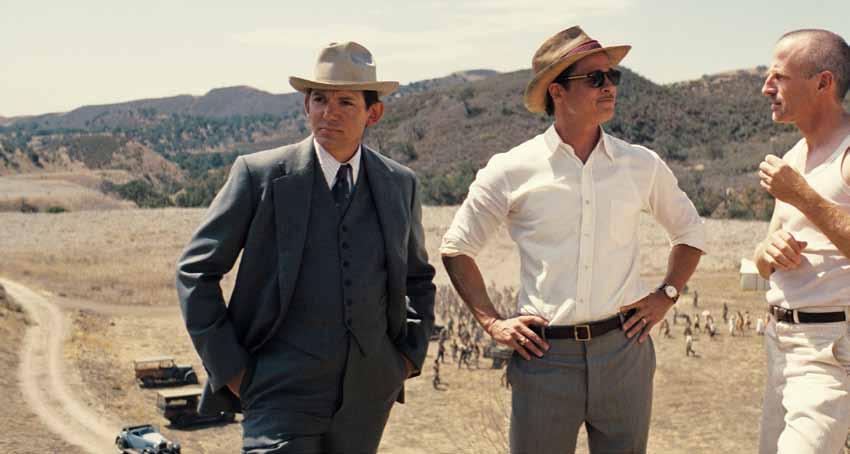 By Katie Walsh
By Katie Walsh
Damien Chazelle would really like to talk to you about “Singin’ in the Rain.” Of course, you already know the 1952 Stanley Donen MGM meta musical comedy starring Gene Kelly and Debbie Reynolds about the transition from silent to sound films, but if not, Chazelle will recount it for you, at great length, and with more bodily fluids, in his three-hour plus Hollywood history lecture “Babylon,” which waffles between being a love letter to cinema and a suicide note.
Chazelle also cribs heavily from another text about the movies, Kenneth Anger’s tawdry 1959 gossip tome “Hollywood Babylon,” filled with outrageous stories about the sex, drugs and scandals that roiled Hollywoodland in the 1920s and ‘30s,
back when people were still figuring out what the motion pictures would be.
“Babylon” is Chazelle’s debauched, dizzying, deviant, depraved, deranged marriage of “Singin’” and “Hollywood Babylon,” also heavily influenced by the most outrageously druggy and hallucinatory filmmaking of Paul Thomas Anderson, Martin Scorsese and David Lynch. The first scene in “Babylon” features a waterfall of elephant excrement descending on the camera, daring the audience (or critics) to call this film a pile of poo. It’s not — the craft is incredible, the star-studded cast is committed, and there are some inspired sequences of bravura filmmaking. The cinematography by Linus Sandgren is virtuosic, edited together bravely by Tom Cross. And yet,
it’s still unclear what Chazelle is trying to do here.
The bloated “Babylon” doesn’t ever add up to anything at all beyond a demonstration of Chazelle’s knowledge of film history. It’s like taking an abbreviated Intro to Cinema class taught by the overcaffeinated TA who can capably link events together but doesn’t otherwise bring any new insight to the material, beyond reinserting all the naughty bits that have been buffed out of the history books.
We meet our Hollywood dreamers, both powerless and powerful, at a raucous soiree hosted by studio exec Don Wallach (Jeff Garlin), a drugfueled orgy/rave/animal show (hence the elephant). A wild-eyed Margot Robbie (dialed up to 11 and the best of the bunch) plays Nellie LaRoy, a self-declared star who muscles her way into the movies by sheer willpower. Nellie has the sordid history and alleged habits of (the real) Clara Bow and the rough, unrefined edges of (the fictional) Lina Lamont.
Nellie meets another Hollywood striver, struggling gofer Manny Torres (Diego Calva) at the party, where they bond over a pile of cocaine and their dreams. Other notable guests include Jack Conrad (Brad Pitt) a womanizing silent-era heartthrob loosely modeled on John Gilbert, Lady Fay Zhu (Li Jun Li), a Sapphic cabaret performer who has an Anna May Wong meets Marlene Dietrich vibe, gossip columnist Elinor St. John (Jean Smart), the Louella Parsons of this world, and Sidney Palmer (Jovan Adepo), a talented Black trumpeter playing in the band. We will follow this group as they chase stardom and find fame fickle, fleeting and ultimately fraudulent. Chazelle structures the sprawling, decades-spanning “Babylon” around its parties: the wild opening rager that features an unfathomable amount of naked writhing and foaming at the mouth, another Wallach affair with a misguided “snake fight,” a country club cocktail party that ends in projectile vomit, and a seedy underground freak show.
He also showcases two highly entertaining movie-making scenes that contrast the difference between the silent (loose, spontaneous, vibrant, dangerous) and sound (stiff, controlled, frustrating,
dangerous) eras. They’re the best parts of “Babylon,” and are anchored by Robbie and a lively performance from Olivia Hamilton (Chazelle’s wife) playing Ruth Adler, a female film director cast in the mold of Dorothy Arzner.
However, as we follow our motley crew as they claw their way to the top of the Hollywood heap (and inevitably fall), it’s hard to care because none of these characters function beyond archetype or reference. They are merely symbols with no sense of inner life or anything insightful communicated about their personal experiences, beyond a few declarative, overwritten speeches. The characters of color, Sidney and Lady Fay, are so sketchily drawn that they end up as tokens, simply nods toward diversity.
The meticulously made mess that is “Babylon” is daring, but Chazelle can’t help but pile hats on top of hats, and it’s the pedantic final minutes that ruin the three preceding hours, as he unspools an atonal, abstract, indulgent montage of film school’s greatest hits. Chazelle can’t seem to land on whether or not he wants to reject nostalgia or eulogize cinema, and ultimately, it’s all incredibly smug for a message, and a movie, so muddled.
2 stars (out of 4)

Rating: R (for strong and crude sexual content, graphic nudity, bloody violence, drug use, and pervasive language)
Running time: 3:08
How to watch: In theaters Friday
article was originally published by Tribune News Service.
This
The bloated “Babylon” doesn’t ever add up to anything at all beyond a demonstration of Chazelle’s knowledge of film history.From left, Lukas Haas, Brad Pitt and Spike Jonze in “Babylon.” (Paramount Pictures/ TNS)
Argentina defeated France on penalties in the World Cup 2022 final last Sunday to earn the third star on their shirt ahead of France. The World Cup in Qatar 2022 will be remembered primarily as Lionel Messi’s World Cup, but the PSG star wasn’t Argentina’s only hero – their victory owed also to Emiliano “Dibu” Martínez, the tournament’s goalkeeper, who won the Golden Glove.
Martínez carried Argentina through extra time and a penalty shootout to win the country’s first world championship in 36 years in the classic World Cup final.

Martínez has undoubtedly been a key player for La Albiceleste. The Aston Villa goalkeeper saved two penalties against the Netherlands in the quarterfinals, and he denied Kingsley Coman in the final to give Argentina the victory.
A looping ball found Randal Kolo Muani in space atop the Argentinian box in the second minute of stoppage time after 120 minutes had already passed. This appeared to be the turning point for France, which had already rallied from 2-0 and 3-2 deficits to tie the game at three. Argentina would be finished, a tragic end to a World Cup that seemed destined to end in favor of La Albiceleste from the start.
“Nothing to thank me for,” Martínez said through both an interpreter and his tears. “It was a game we had to suffer. … It’s our destiny to suffer.”
And it seemed to be his destiny to put an end to that agony.
“We were [up] 3-2, they get another penalty. They almost scored two goals then I did that kick, that save, and this is my dream,” Martínez said. “I’m speechless.”
When asked about the penalty kicks, he still
burst into tears.
“I was cool ... I had to rely on my teammates,” he explained. “But then I did everything right.”
The statistics back up Martínez’s consistency in critical moments. Argentina head coach Lionel Scaloni used seven different goalkeepers in his first 49 games in charge before settling on him as first choice.
Martínez has kept 17 clean sheets and conceded only 13 goals (excluding penalty shootouts) in 26 appearances for his country, including Sunday’s World Cup final.
Martinez’s difficult childhood, in which money and basic necessities were scarce, prompted his move to England at the age of 17 and may explain the tenacity that has propelled him above the slew of goalkeeping deputies who never quite make it. “I’ve always had to fight,” he admitted.
From Oxford United in England’s fourth tier in May 2012 to the best keeper on the world’s biggest stage in December 2022, it’s been quite the journey.

Emiliano Martínez of Argentina was an unwant-
ed
Connect Oxford United (England’s fourth division in 2011-12), Sheffield Wednesday (second division in 2013-14), Rotherham United (second division in 2014-15), Wolves (second division in 2015-16), Getafe (Spain’s top division in 2017-18), and Reading (England’s second division in 2018-19). It’s all about the clubs Emiliano Martínez has spent the last decade on loan after joining Arsenal as a teenager in 2010.
Martínez witnessed firsthand Wenger’s latecareer Arsenal struggles. He was involved in a wild 12-goal thriller in which he conceded four
Arsenal goalkeeper who was loaned out for the better part of a decade. Then Bernd Leno’s injury changed everything. On Sunday, he became the world champion.Martínez didn’t make his senior international debut until June 2021, following an outstanding season for Aston Villa, but his legend grew quickly.Argentina goalkeeper Emiliano Martínez. Photo: (Franck Fife/AFP)
goals in the first half before Arsenal won 7-5. Some of the defending was questionable, but Martinez did not come away unscathed. While he has played under all three of Arsenal’s then current managers (Wenger, Unai Emery, and Mikel Arteta), none of them saw Martínez as the man they wanted behind the goal. So, until June 2020, Martínez’s most memorable appearance in an Arsenal shirt would be the 12-goal thriller against Reading in 2012. An injury to Bernd Leno, a signing by Emery in 2018, changed everything for Martínez. The
German suffered a serious injury in one of the first games back after the pandemic. With the transfer window closed, Arteta had no choice but to approach the Argentine. Martínez joined fellow Premier League club Aston Villa in a deal worth up to £20 million on September 16, 2020. He agreed to a fouryear contract. Martínez made his Villa debut on September 21, saving a penalty from John Lundstram in a 1-0 home win over Sheffield United. Martínez was named Aston Villa Supporters’ Player of the Season.
Martínez signed a three-year contract extension with Villa on January 21, 2022, keeping him with the club until the end of the 2026-27 season. On July 27, ahead of the new season, Martínez was named one of the two Aston Villa vice-captains, alongside Diego Carlos.
Martínez didn’t make his senior international debut until June 2021, following an outstanding season for Aston Villa, but his legend grew quickly. Martínez was called up to Argentina’s senior squad in June 2011 to replace Oscar Ustari against Nigeria. He received his second sen-

Emiliano Martínez of Argentina was an unwanted Arsenal goalkeeper who was loaned out for the better part of a decade. Then Bernd Leno’s injury changed everything. On Sunday, he became the world champion.
(IMAGO/ Bildbyran/Joel Marklund)
ior call-up on October 9 and 13, 2019, against Germany and Ecuador, respectively. He was an unused substitute in both friendly matches.
Martínez made his international debut on June 3, 2021, in a 1-1 draw with Chile in a 2022 FIFA World Cup qualification match.
On June 14, he made his competitive debut in a major tournament for the second time, drawing 1-1 with the same opponent in his team’s opening match of the 2021 Copa América at the Estádio Olmpico Nilton Santos in Brazil.
Martínez saved three penalty kicks in Argentina’s 3-2 penalty shootout win over Colombia in the tournament’s semi-final on July 6.

He went on to finish the tournament with a clean sheet in the final, a 1-0 victory over Brazil. Martínez was also awarded the 2021 Copa América’s Golden Glove award as the best keeper of the tournament for his performances.
On June 1, 2022, Martínez kept a clean sheet as Argentina won 3-0 against reigning European Champions Italy at Wembley Stadium in the 2022 Finalissima.
Martínez’s been dubbed “Dibu” (Spanish for “Drawing”) after an animated character in the
Argentine telenovela Mi familia es un dibujo. He was given the nickname as a young player at Club Atlético Independiente during the height of the series’ popularity. In 2018, Martínez signed a sponsorship agreement with Puma.
Since 2017, Martínez has been married to Amanda “Mandinha” (née Gama). The couple has a son named Santi and a daughter named Ava.
Martínez has achieved success in the business world in addition to his achievements on the field. The 30-year-old now has his own playable NFT character in MetaSoccer, a football metaverse where video gamers can manage their own club and earn cryptocurrency based on the performance of their players.
Meanwhile, the ex-Arsenal goalkeeper is the face of Argentina’s largest fast-food chain, Mostaza. He has even introduced his own hamburger, the “Mega Dibu,” at the restaurant.
Martínez has also written a children’s book called Dibu Martínez, Pasión por el Futbol (Dibu Martínez, Passion for Football), in which he discusses his career, how he fell in love with the sport, and the hard work that led to his success. The book was published in October.

Argentinian President Alberto Fernandez has caused a political stir since he first burst into the limelight of Argentine politics in 2019 as a politician who was running for president.
Although Fernandez served under both former President Cristina de Kirchner and her husband, former President Néstor Kirchner, he did not have the same prominence as them.
This week, the final match of the 2022 Qatar World Cup brought Argentina onto the pitch against France, and President Fernandez decided to watch from his home, fearing that it would be a bad omen for Messi and his companions.
Argentinian presidents have preferred not to personally attend any matches in the stadium again after Argentina lost 1-0 to Cameroon at the start of the 1990 tournament, which was in the presence of the Argentine President at the time, Carlos Menem.
President Fernandez was unable to meet
his country’s national football team, but he highlighted the unprecedented and huge celebration in the streets of Buenos Aires and its environs on Tuesday to celebrate his country’s victory in the Qatar 2022 World Cup.
In a tweet, Fernandez said, “I celebrate how the people took to the streets to pay homage to our national team. Millions of Argentines in the streets, in an uncommon December, which will remain forever in our hearts.”
“We were all able to thank with unity and harmony the immense joy that they gave us. As president, I join in this,” the Argentine president added.
Last Sunday, Argentina was crowned champion at the World Cup for the third time in its history by winning the Qatar 2022 final against France on penalties (4-2), after the original and extra-time game ended in a draw (3-3).
Fernandez, 63, graduated from law school, played guitar for a while, and entered politics for the first time in the early 1980s.
For most of his political career, Fernandez has been a member of the Justice Party, which follows the principles of populist ex-
president Juan Perón and is now part of the main center-left opposition coalition, Frente de Todos.
Fernandez headed President de Kirchner’s election campaign in 2003, then de Kirchner’s wife’s presidential campaign in 2007, and he held the position of Prime Minister during their respective years of rule of the country.
He resigned in 2008 after a sharp dispute with President Christina de Kirchner, and opposed policies such as attempts to politicize the judiciary and limit the influence of a powerful opposition media group.
After leaving his duties, he became an outspoken opponent of his former boss, but then dismissed their differences and said that “it happens to many Argentines, as you disagree with friends because you do not agree with a policy.”
The Argentinian president is seen as a unifying force that brings together pro- and anti-Peronist forces, or Social Justice, a political movement based on the ideology of former Argentine President Perón’s “Frente de Todos,” a broad front focused on removing President Mauricio Macri from office.

 By Renata Geraldo
By Renata Geraldo
Jarvis moves slowly, yet meticulously, from one station to another to make a cup of cappuccino. Jarvis makes the espresso, pours the milk, steams the foam and puts it all together, topping it off with a carefully drawn foam leaf.
The result is a cup of cappuccino, ready to go. What stands out about this cappuccino? Its maker. Jarvis is a robotic arm, not a human barista, at Artly in Pike Place Market.
While Jarvis is busy, a human staff focuses on interacting with customers, explaining the concept to
newcomers and placing orders using a tablet.
Seattle-based robotic startup Artly, founded in 2020, has seven locations in Washington, Oregon and California. The highlight at each location is a unique barista bot that has its own name, gender, voice, accent and personality. The robot’s techniques differ at each location as they learn from a different human barista.
It is intriguing to see the robot’s coffee-making techniques, but pressing market needs were behind the innovation. Cost concerns and high employee turnover in food services have led Artly and others to provide automated solutions to restaurants and businesses, even before the pandemic hit and brought additional challenges.
Just a couple of years into operation, Artly CEO Meng Wang said the company has maintained healthy operating margins — the profit a company makes after paying for costs of production — by eliminating the biggest expense in food business: labor.
For a coffee shop that would need two or three baristas, Artly needs one staffer, in addition to a barista bot like Jarvis. Artly reinvests the money it saves from labor into sourcing more quality coffee, Wang said.
Artly isn’t alone in introducing robot help in food preparation. Another Seattle-based startup, Picnic, offers automation solutions for a staple of the American diet: pizza. Its food prep station can produce up to 100 pizzas in one hour using metered toppings.
Since Picnic was founded in 2016, its robots have assembled pizzas in many places, including Seattle’s T-Mobile Park and the Las Vegas Convention Center. The company has seen a growing interest in its robots. This summer, Picnic announced partnerships with pizzeria Moto’s West Seattle location and a Domino’s store in Berlin.
The startups behind these robots tout their automated solutions for bringing higher productivity and reducing costs. Automating pizza assembly can help restaurants reduce food waste and potentially save money, said Picnic CEO Clayton Wood. For

example, it helps keep the amount of toppings even.
By automating the process with preset topping amounts, pizza-making can be more cost-effective, Wood said.
Automated solutions also fill a gap in finding and retaining workers. Food service jobs can be “tedious and can be dangerous, and there’s very high turnover,” Wood said. “There’s no advancement and the working conditions are not great.”
Issues in productivity and turnover in the food industry predate COVID-19, said Geoff Harris, a Picnic investor and co-founder and managing partner of venture capital firm Flying Fish Partners. But the need grew with the pandemic as restaurants closed. Many employees were laid off or furloughed and did not go back to the food industry.
Staffing levels at eating and drinking establishments remain below their pre-pandemic levels as demand for labor nationally remains high, according to a National Restaurant Association analysis of U.S. Labor of Bureau Statistics data in November.
Robots can’t fill in for humans in every setting, however. Joe Yang, owner of several coffee stores in Portland, who is also Artly’s co-founder and chief coffee officer, experienced that firsthand at his coffee shops.
Yang tested Jarvis’ beta version at his own stores. His customers were initially intrigued and excited about the robot barista, but the service was slower
Artly isn’t alone in introducing robot help in food preparation.
Another Seattle-based startup, Picnic, offers automation solutions for a staple of the American diet: pizza.A sandwich-board advertises “barista bot” coffee at Artly, Wednesday, Nov. 30, 2022, in downtown Seattle. (Ken Lambert/ The Seattle Times/ TNS)
than with a human barista. He said customers craved the connection with the person making their coffee. “When [customers] go to the coffee shop, their expectation is to be served by a human,” Yang said. With that, Artly has focused on opening locations in shopping malls and business office buildings rather than standard coffee shops.

Artly also has seen an opportunity to expand in areas lacking coffee shops because of the pandemic or where Starbucks stores closed.
“During COVID-19 there were a lot of ‘coffee deserts,’ and the competition is clearly much less than before,” Wang said.
For example, its first location opened at Japanese
retailer MUJI in Portland in May 2021, after a previous coffee operator left due to labor shortages. Similarly, Jarvis made a home at Stoneridge Shopping Center in Pleasanton, California, in December 2021 because there was no coffee operator there.
Because Starbucks had exclusivity as the only coffee provider in some areas, consumers had no other coffee options when it left, CEO Wang said. This was the case in the Stonestown Galleria Shopping Center in San Francisco where Artly opened its location in August.
While the need and opportunities exist, some startups are beginning to feel the squeeze. Inflation and recession fears this year have led to a stock market downturn, dampened investor appetite for risk and led to a decrease in venture capital activity.
Hardware, Picnic’s area, can be considered a risky investment, Wood said.
“The current investment market is a challenge,” Wood said. “We could go much faster in our product development and our market expansion if we were operating in a different market condition.”
Jarvis, a “barista bot” wearing a little elf cap that stays on even when upside down, can make ornate foamed milk art on espresso drinks like this cappuccino, seen last month at Artly in downtown Seattle.
(Ken Lambert / The Seattle Times)
It is intriguing to see the robot’s coffee-making techniques, but pressing market needs were behind the innovation.
Casey Myers, right, marvels at Amanda, a “barista bot,” making ornate foamed milk art on Myers’ dirty chai latte at Artly in Pike Place Market. “I can’t believe a robot can do latte art,” Myers said.
(Ken Lambert / The Seattle Times)
Wood declined to comment on the company’s fundraising, but GeekWire reported last year that Picnic raised $20.5 million in early-stage funding, led by California-based venture capital firm Thursday Ventures. Flying Fish, Vulcan Capital Management and Creative Ventures also participated in the round.
By the end of 2021, investment activity slowed, with fewer initial public offerings and stock market losses. Those factors have “made the VC market significantly more conservative than in the prior several years,” Wood said.
Still, with a modular hardware system, Picnic’s robots are easy and cheap to build, Flying Fish’s Harris said. With a robotics-as-a-service business model, the standard full offering for operators is $4,500 a month on a 36-month contract.
Artly’s CEO Wang said the company hasn’t struggled with funding. It closed a funding round of $8.5 million this year and a $1.5 million round last year. Both rounds were early-stage investments.
Both Picnic and Artly are still young startups. And despite possible economic challenges, both have
plans to scale the business.
Picnic has partnered again with Moto to install a food prep station at the pizzeria’s downtown location, though the unveiling date is still unclear. More partnerships are on the horizon, according to Wood and Harris.
At Artly, when the barista bots becomes more stable and reliable in making coffee, Wang said the next step will be franchising, though that goal is still some years ahead. In 2023, the company plans to scale by adding between 15 and 20 locations.
This article was originally published by The Seattle Times.

The startups behind these robots tout their automated solutions for bringing higher productivity and reducing costs.By Matthew Solan
Science has long held a skeptical view of the placebo effect, in which a person derives a physical benefit from a sham treatment. But evidence suggests that the placebo effect is the real deal.

“The placebo effect is more than positive thinking -- believing a treatment or procedure will work. It’s about creating a stronger connection between the brain and body and how they work together,” says Ted J. Kaptchuk, director of the Program
How the placebo effect works is still not fully understood. Researchers believe it involves a complex neurobiological reaction that increases feel-good neurotransmitters, like endorphins, serotonin, and dopamine, and greater activity in specific brain regions linked to mood, emotional responses, and self-awareness. Together, these can create a therapeutic benefit.
“The placebo effect is a way for your brain to tell the body that it can feel better,” says Kaptchuk. But the placebo effect is not only about enlisting and releasing extra brainpower. You also need the ritual of treatment for it to be effective, according to Kaptchuk.
“When studies compare drugs with placebos to see if they work, people are exposed to an environment and procedures geared toward improving one’s health,” he says. “You must visit a clinic at certain times and be examined by medical professionals. You undergo procedures or receive special medication. All this can profoundly impact how the body perceives symptoms because you feel both consciously and unconsciously that you are getting the attention and care needed to heal.”
Placebo treatments are most effective for reducing pain and easing cancer treatment side effects like fatigue and nausea. However, they do not heal. “Placebos may make you feel better, but they will not cure you,” says Kaptchuk.
While their lasting effects are unknown, placebos have shown to work for the same duration as regular treatments in many trials, whether the study lasts 12 weeks, six months, or a year.
It was thought that the placebo effect only worked through deceitfulness -- that is, you have to be tricked into thinking a treatment is real. But new research suggests that it may be possible to receive a placebo’s effects even if you know treatments are fake, a concept known as open-label placebos.
A study in the September 2021 issue of the journal Pain explored open-label placebos in treating people with irritable bowel syndrome (IBS).

Approximately 250 people with moderately severe IBS symptoms were randomly divided into two groups. One followed a traditional placebo-controlled format, where half received either a pill containing peppermint oil or a placebo. They were not told which one they took.
(Peppermint oil may help with IBS symptoms like cramping and bloating.) The other group took only the placebo but was told it was fake medication (open-label placebo). Participants took the pills three times daily, 30 minutes before meals, for six weeks. Afterward, a majority of both the placebo-controlled and the open-label groups reported similar reductions in their IBS symptoms.
This was only one study, but other studies using open-label placebos have shown similar results for low back pain, can-
cer-related fatigue, migraines, and knee osteoarthritis.
“This is a major shift in how placebos were believed to work,” says Kaptchuk. “Many doctors thought placebos needed deception to work, but these findings suggest that may not be true.”
So how can the placebo effect work if you know a treatment is not real? Theories abound, but Kaptchuk speculates that the ritual effect may be more potent than previously known.
“People associate the routine of taking medicine with a positive healing effect,” says Kaptchuk. “Even if they know it’s not medicine, the action itself can stimulate the brain into thinking the body is being healed. And the more ritualized the treatment, the more serious and important it feels.”
Given this, the next question is whether it’s possible to give yourself a placebo effect. “Perhaps, but you still need a strong patient-doctor relationship and the ritual of treatment for placebos to work,” says Kaptchuk. “You probably can’t take Tic Tacs on your own and convince yourself it will help your back pain.”
Still, it’s conceivable to tap into the placebo effect’s benefits by adopting rituals of healthy living and self-help, such as healthy eating, exercising, and meditating, Kaptchuk adds.
“While these activities are positive interventions in their own right, the level of attention you give them can enhance their benefits, which in some ways is similar to a placebo effect,” he says. “If you expect these activities to help you get better, it’s quite possible you will.”
This article was originally published by Harvard Men’s Health Watch.
“The placebo effect is more than positive thinking -- believing a treatment or procedure will work. It’s about creating a stronger connection between the brain and body and how they work together.”Credit: TNS



























